LECTURES IN THE ENGLISH THEORETICAL GRAMMAR Angelina Vasilyevna



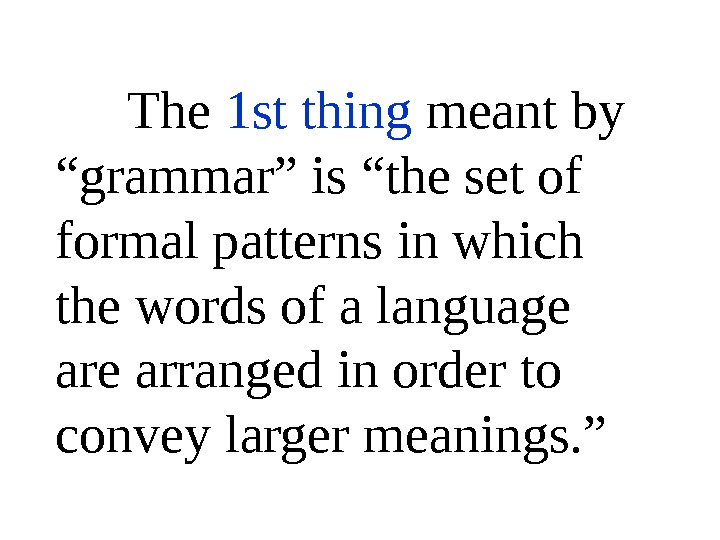



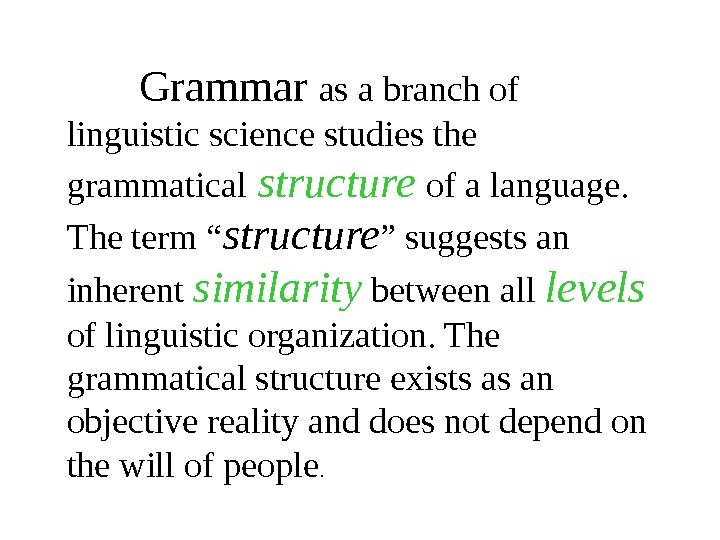
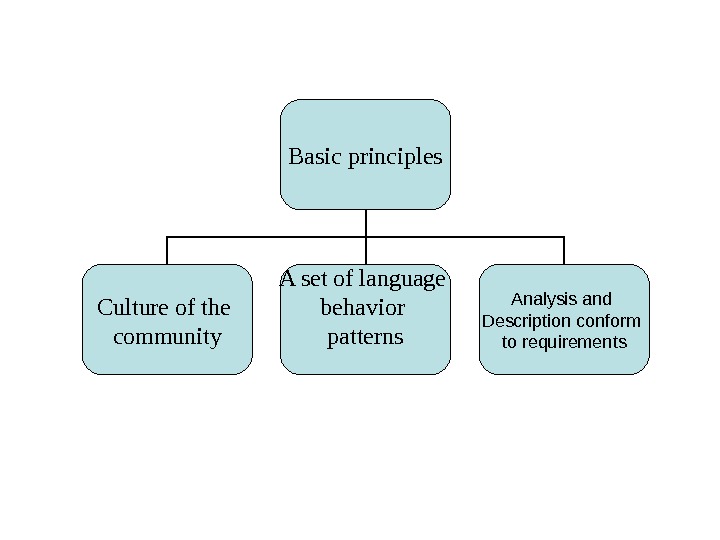

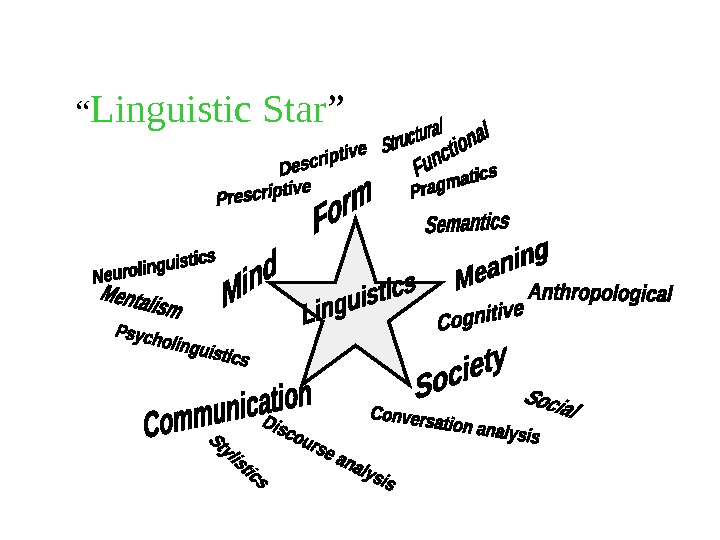
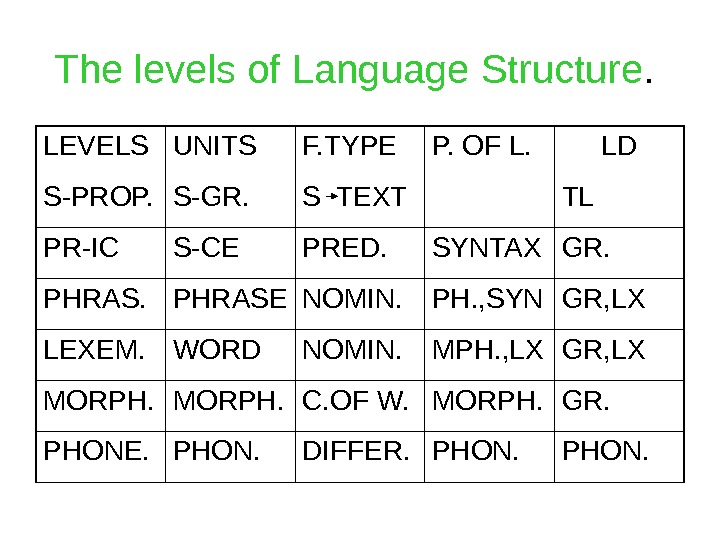
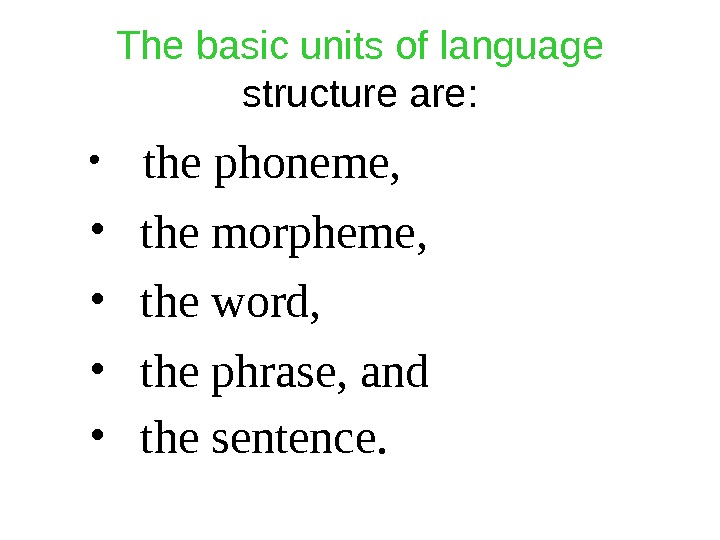



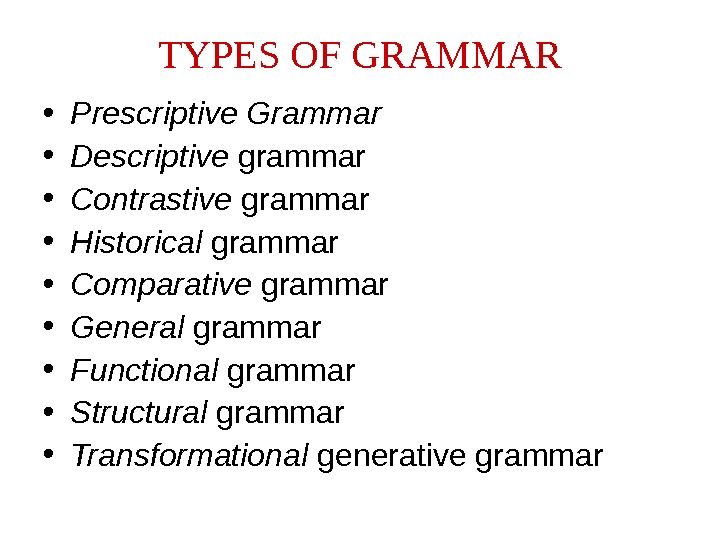
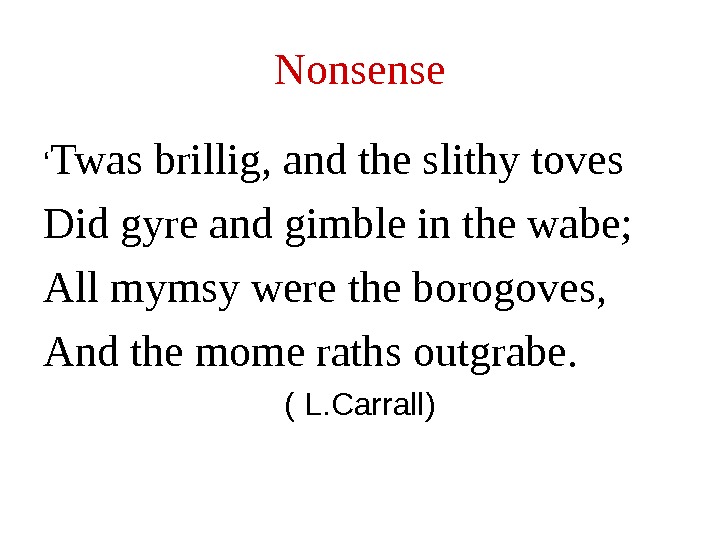
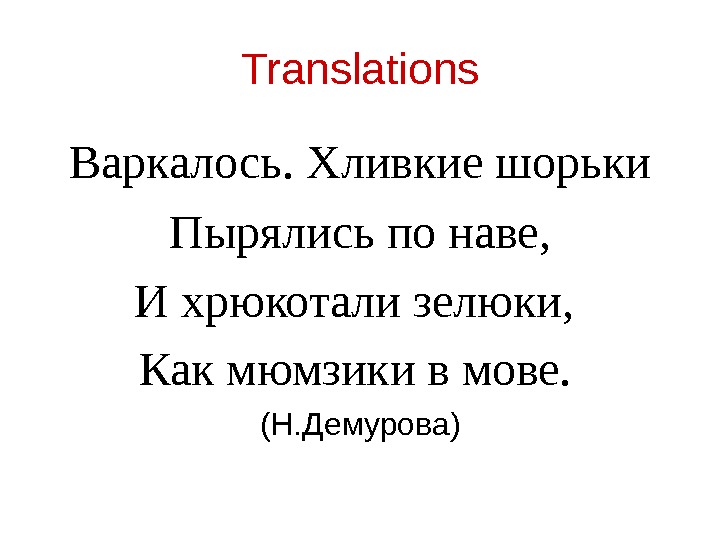




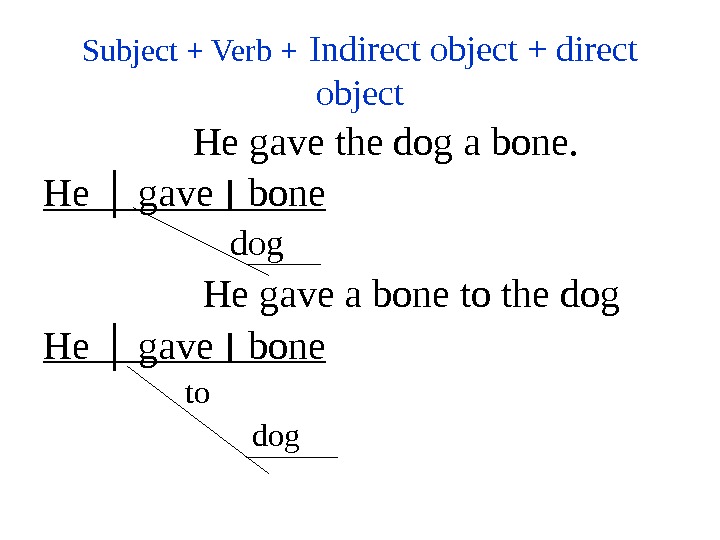

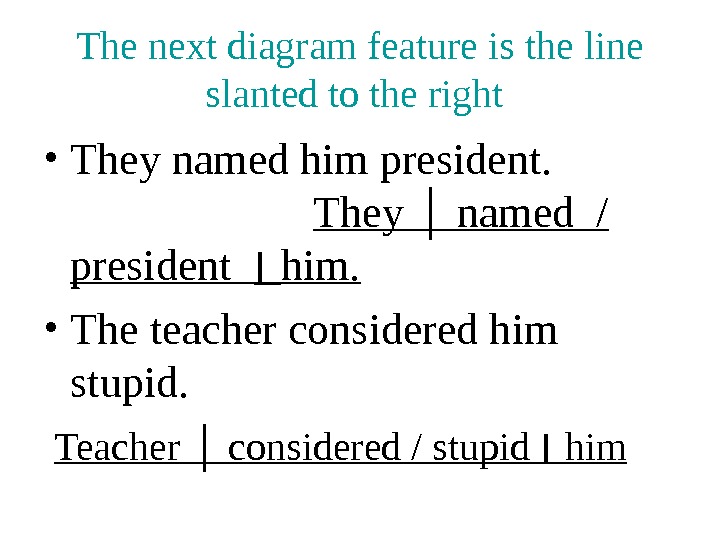

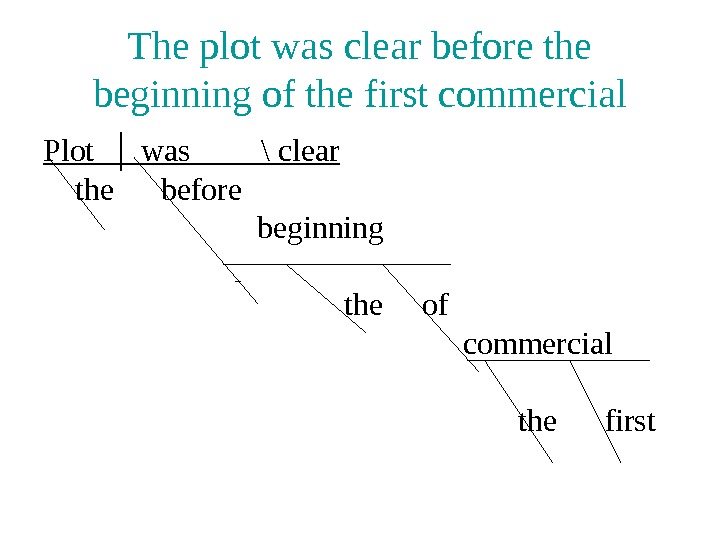





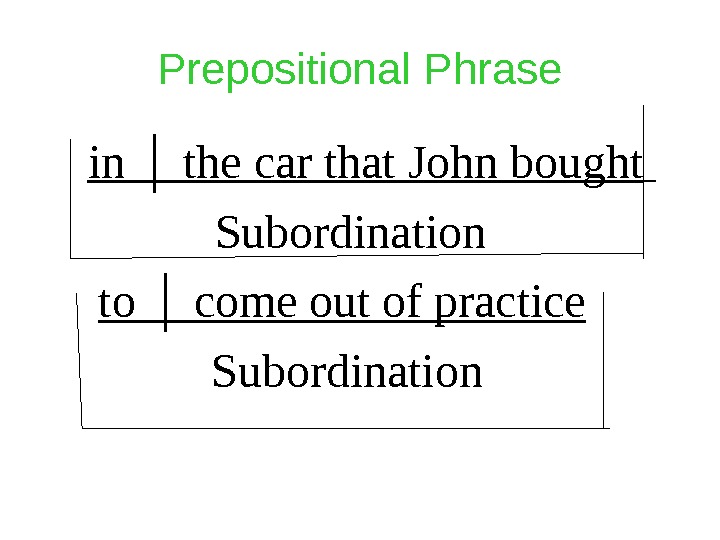
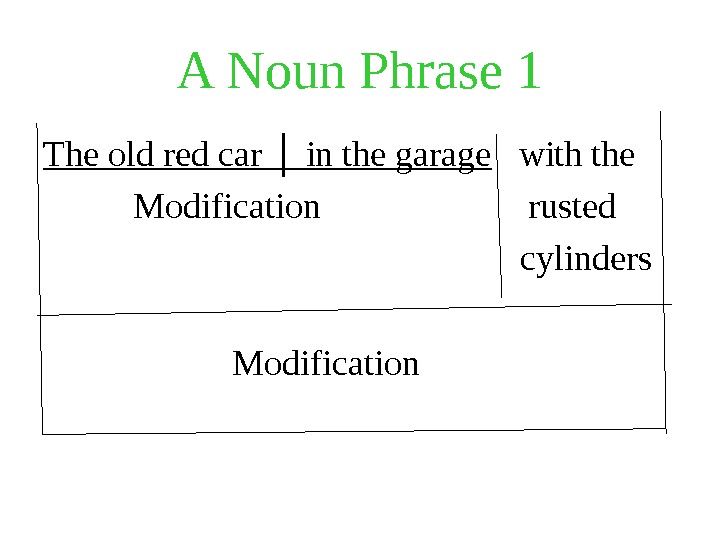

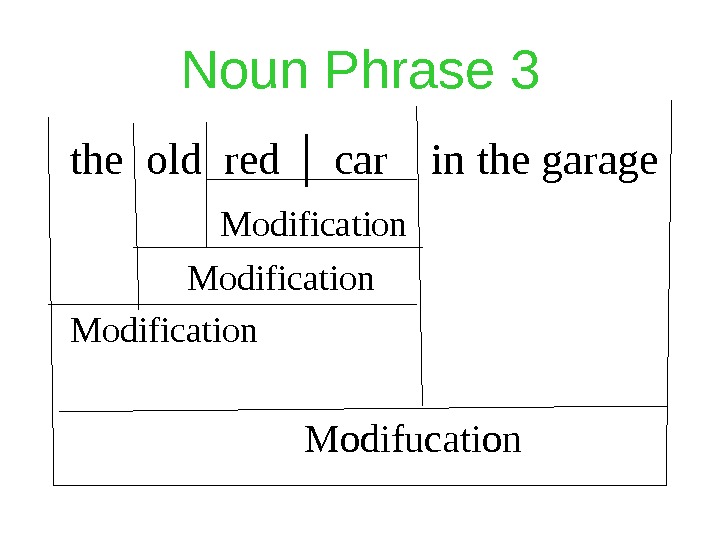






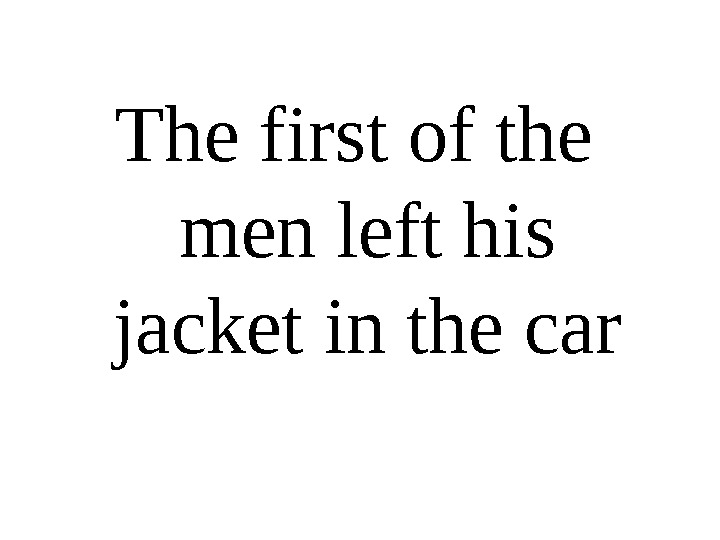
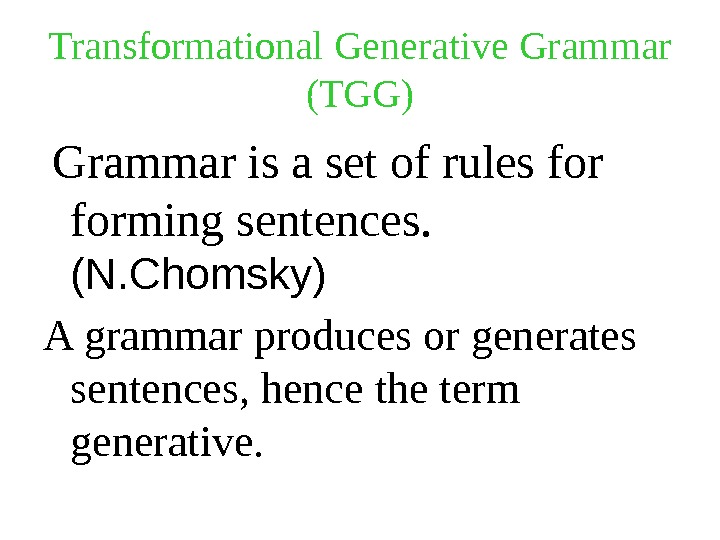
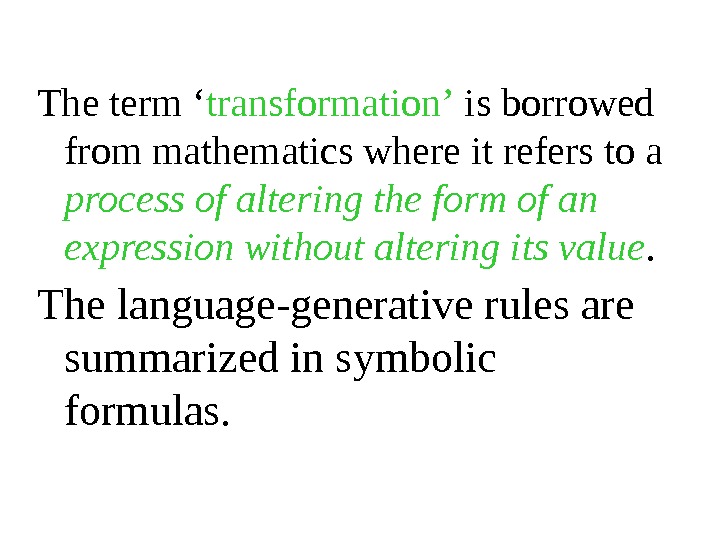
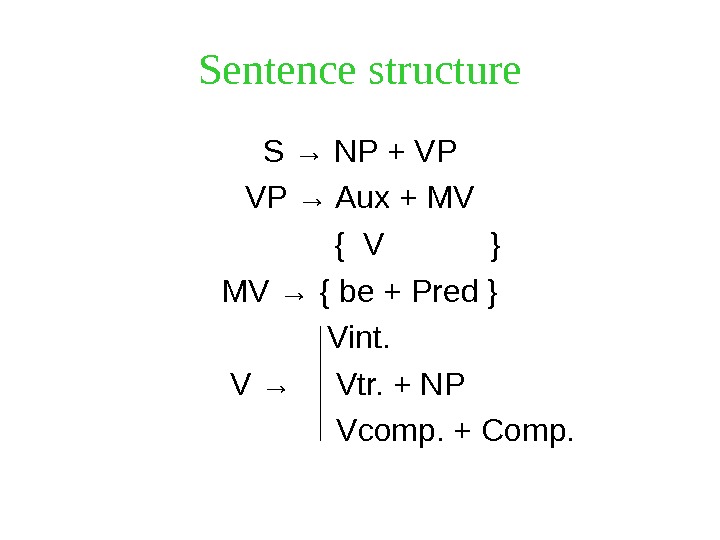
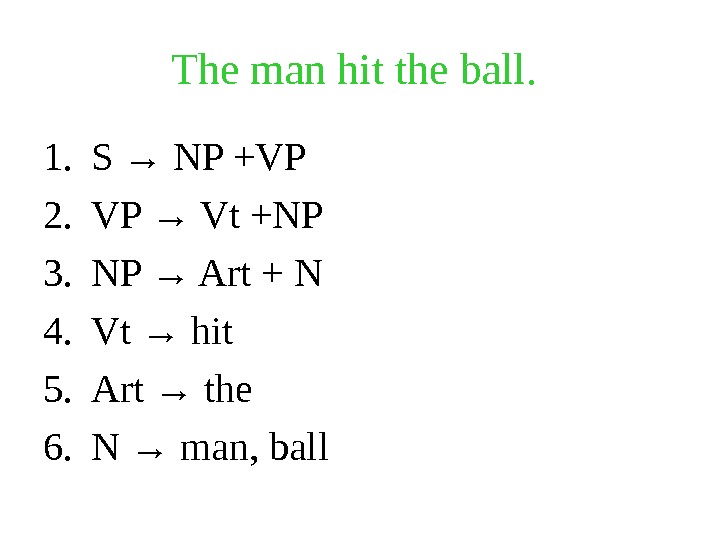

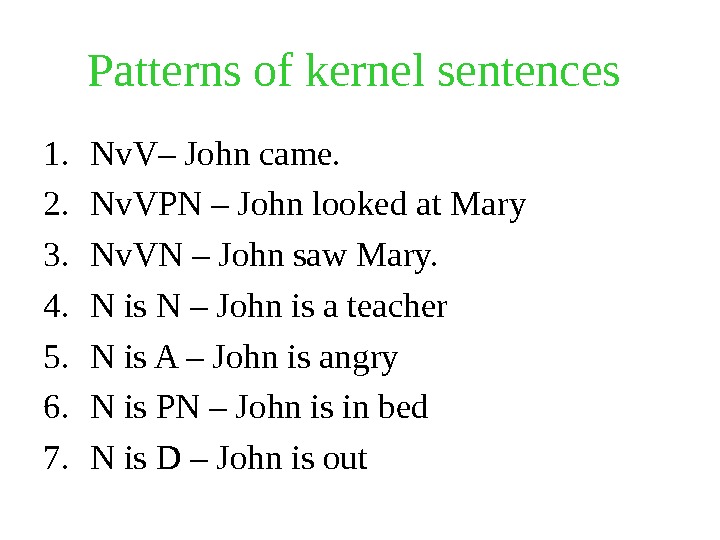





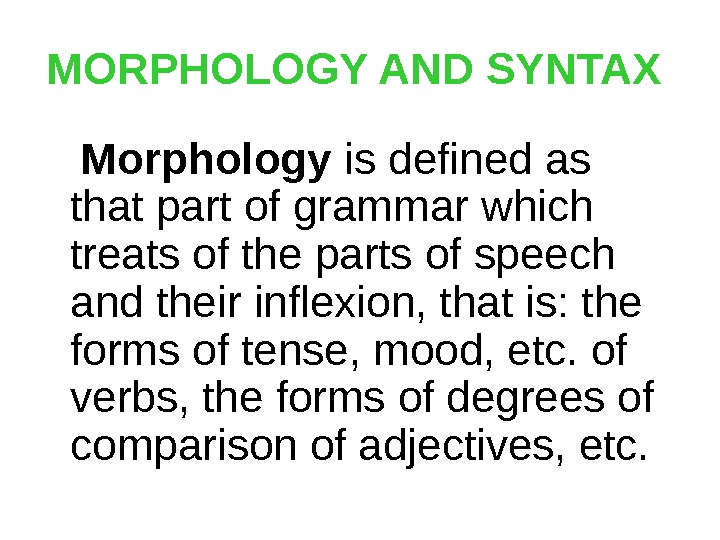
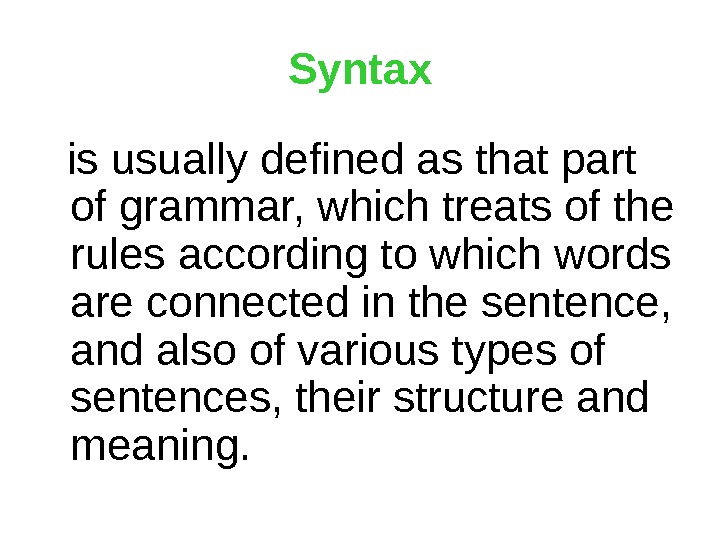

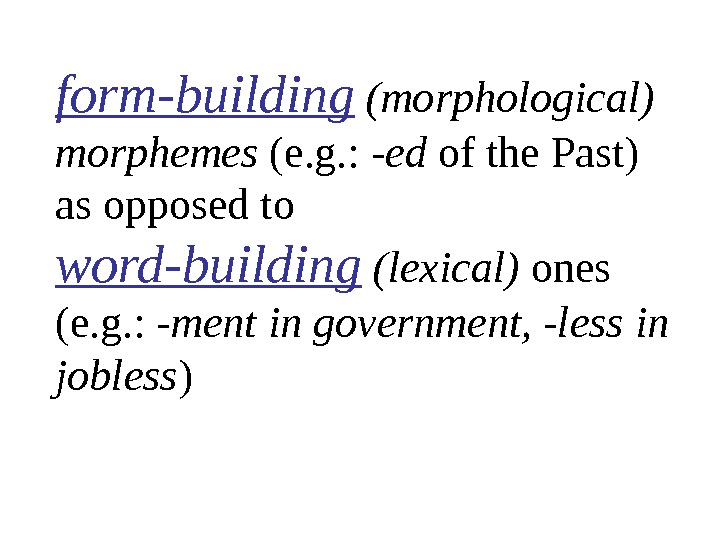
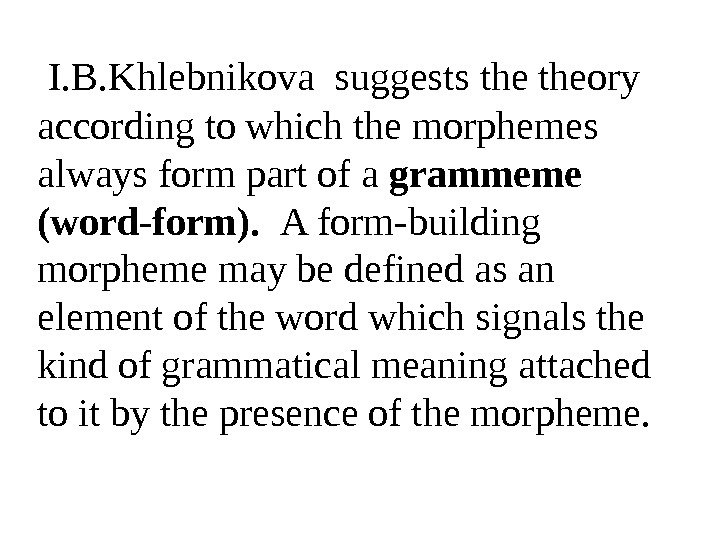
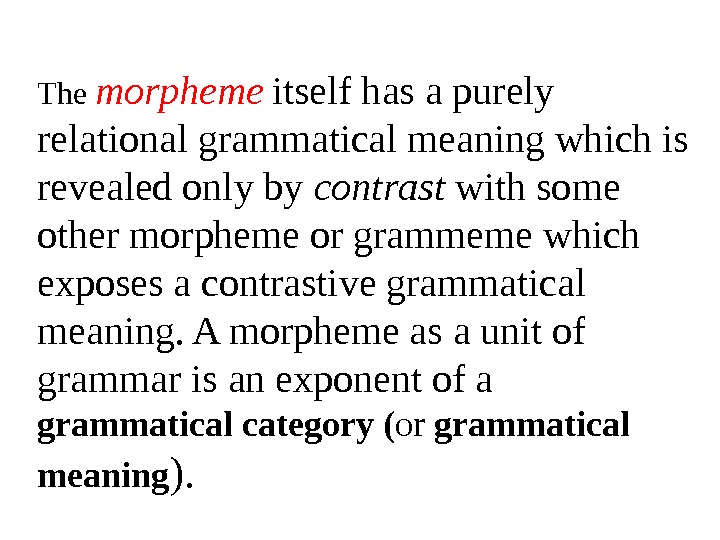

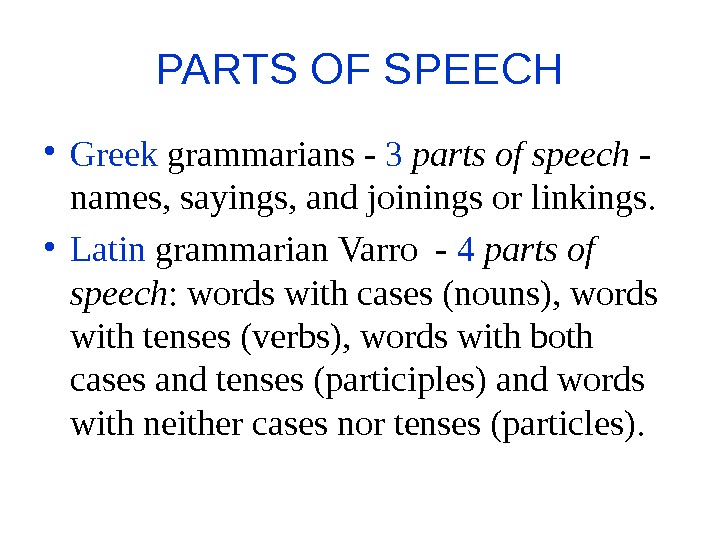
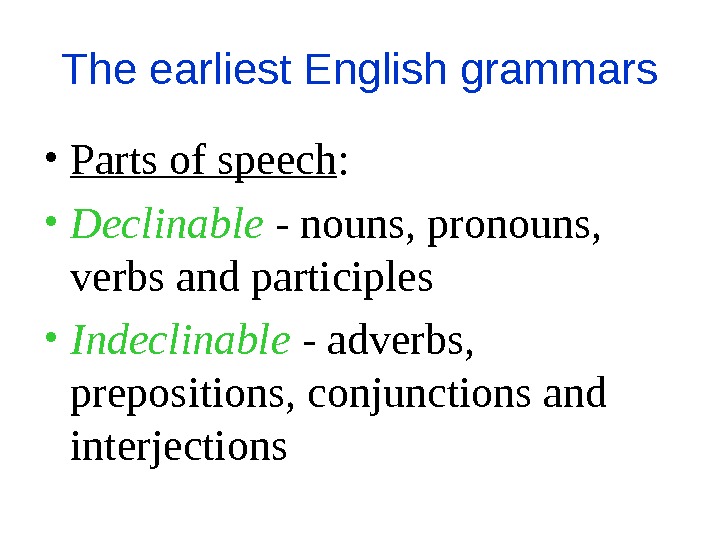


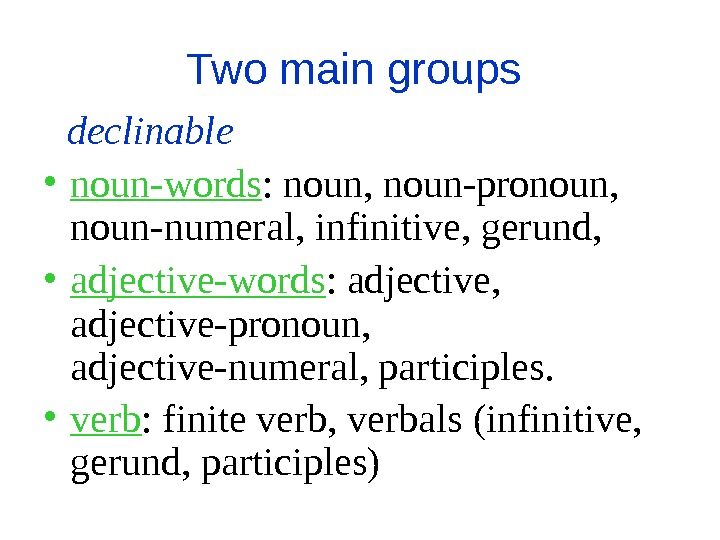
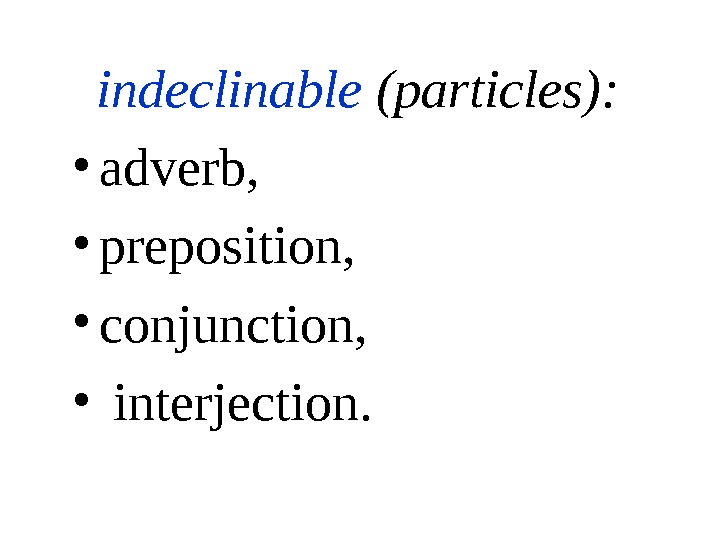
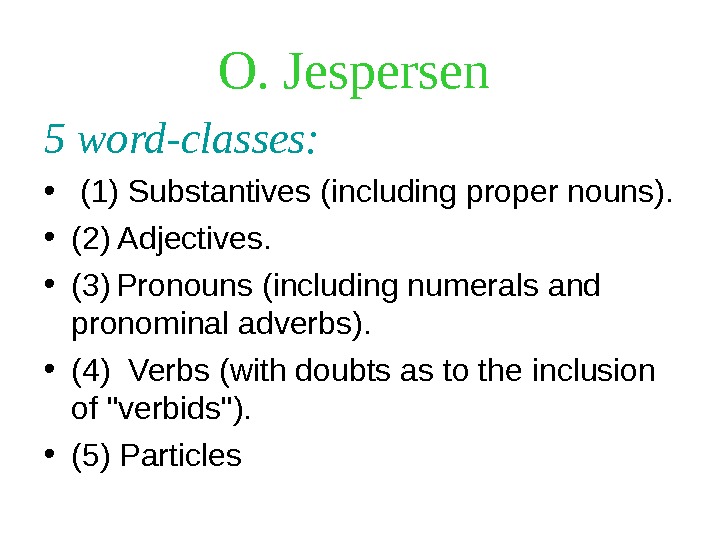





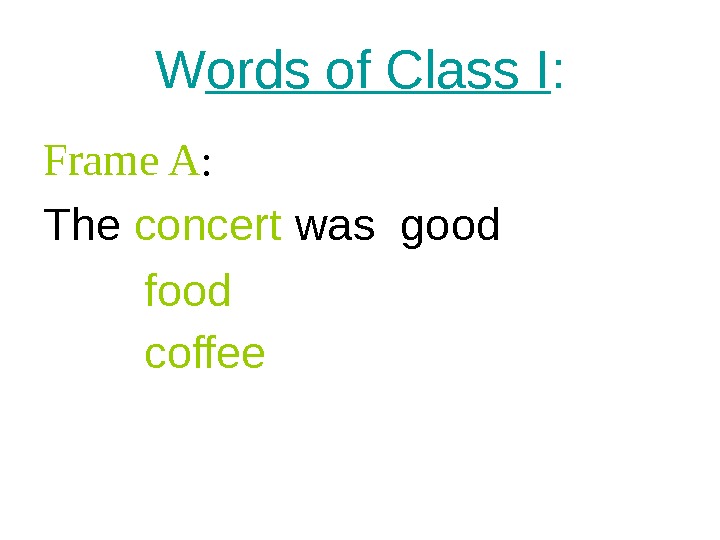
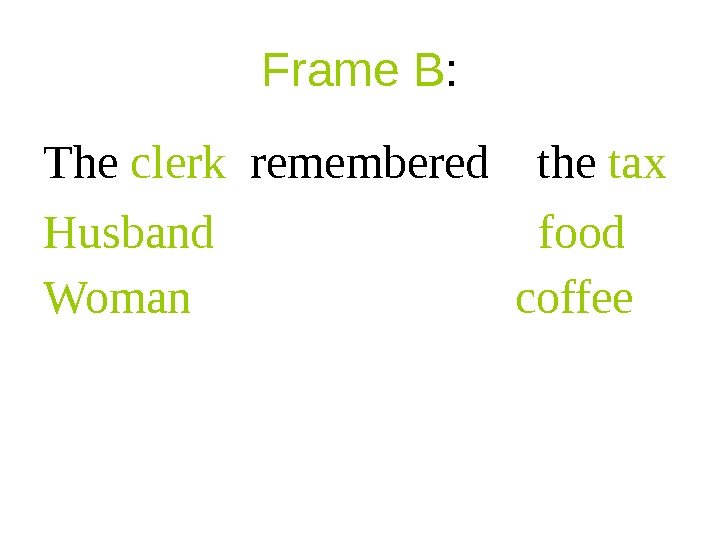



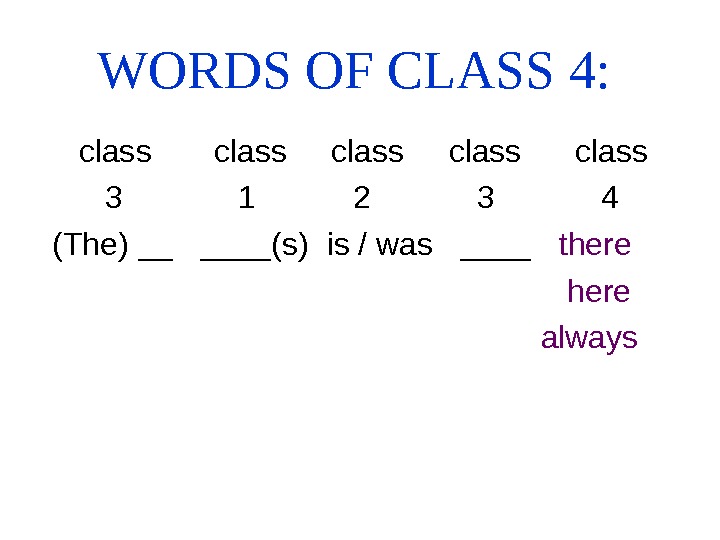
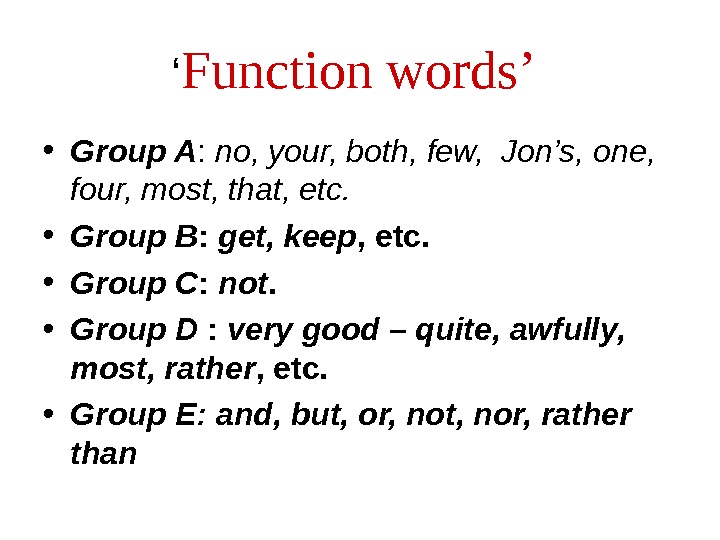
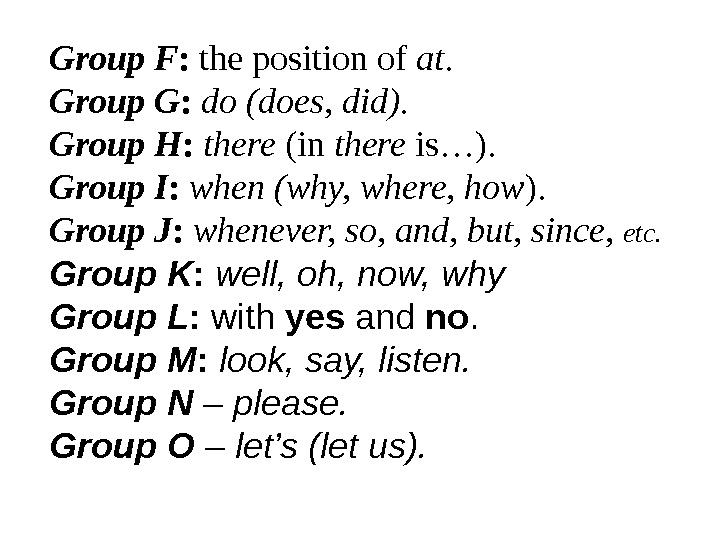
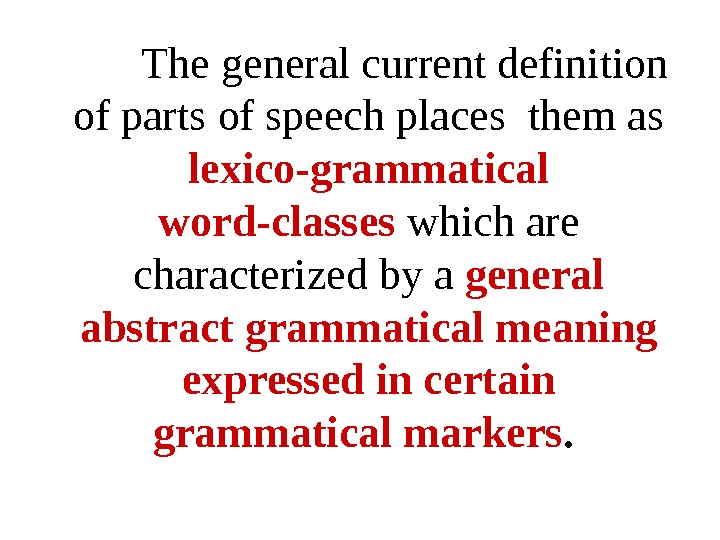

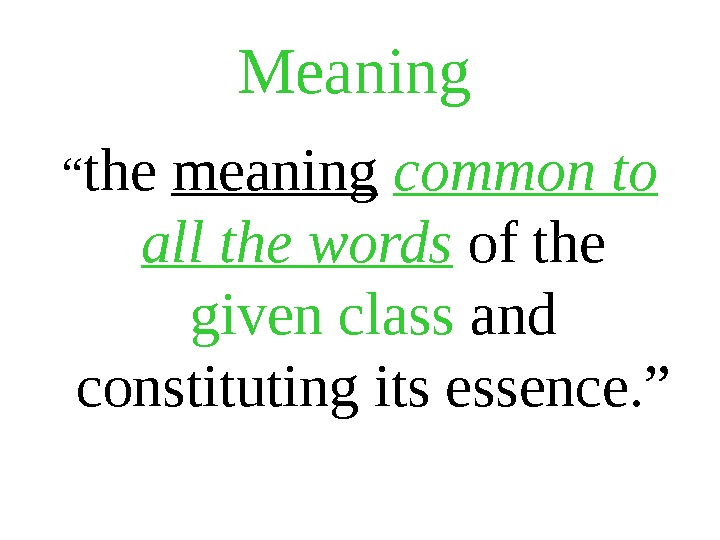




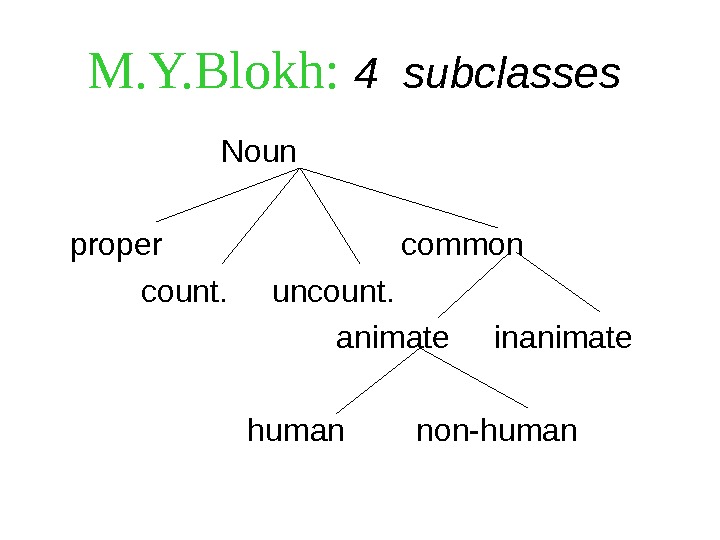

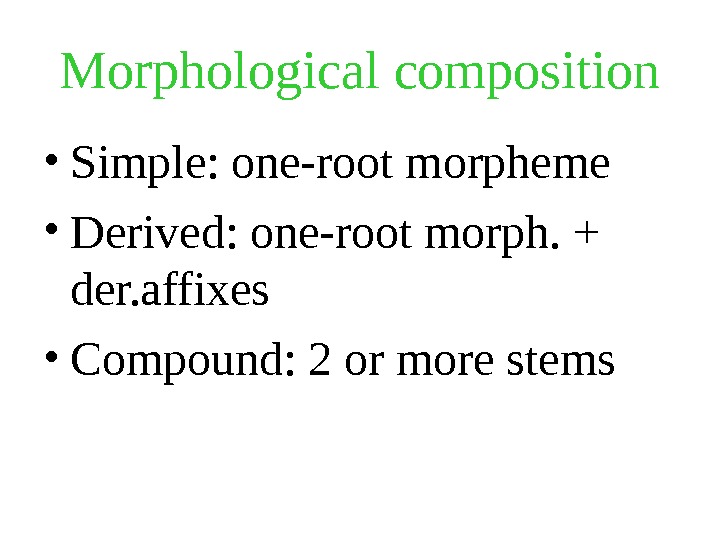
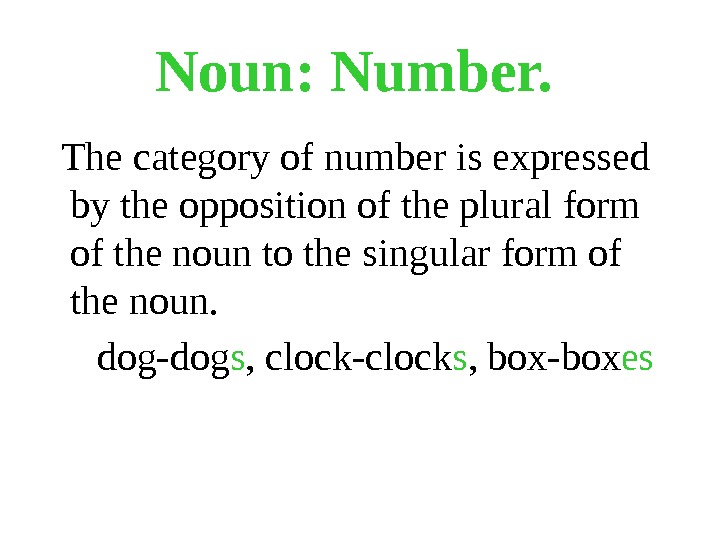

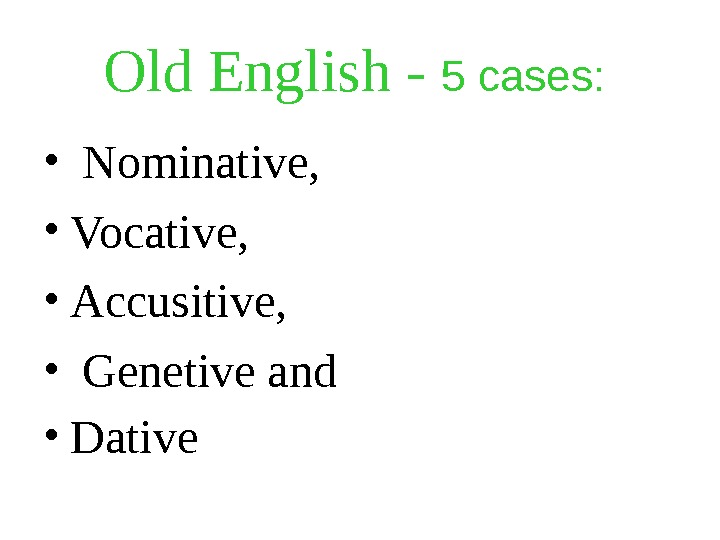
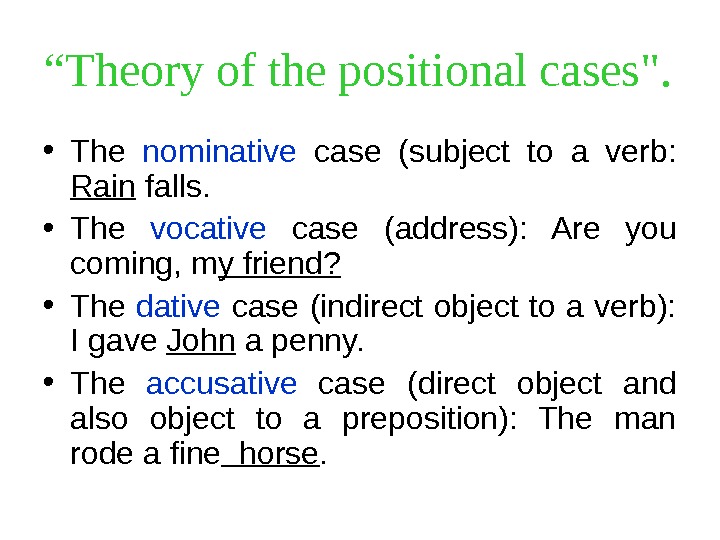


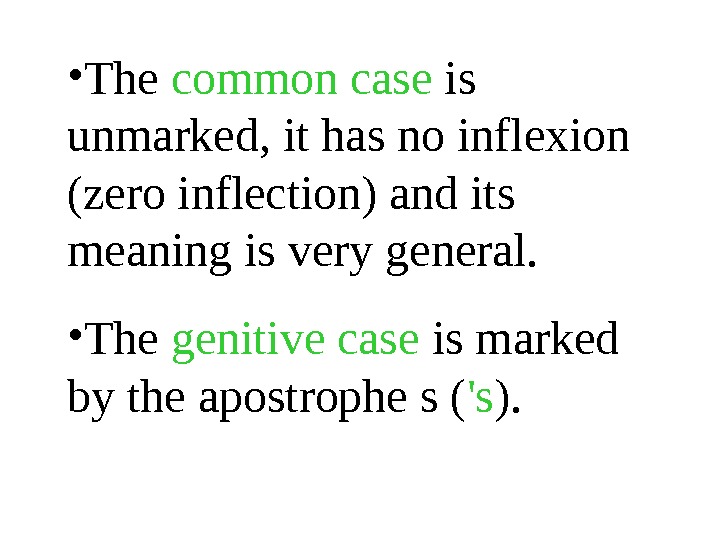
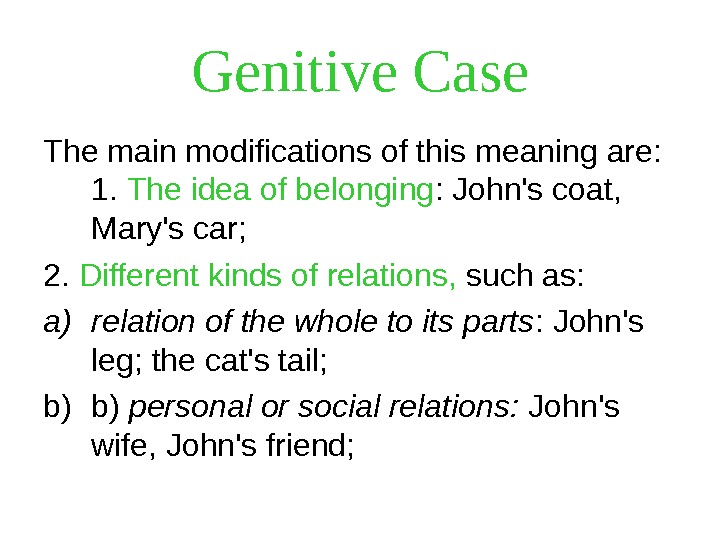
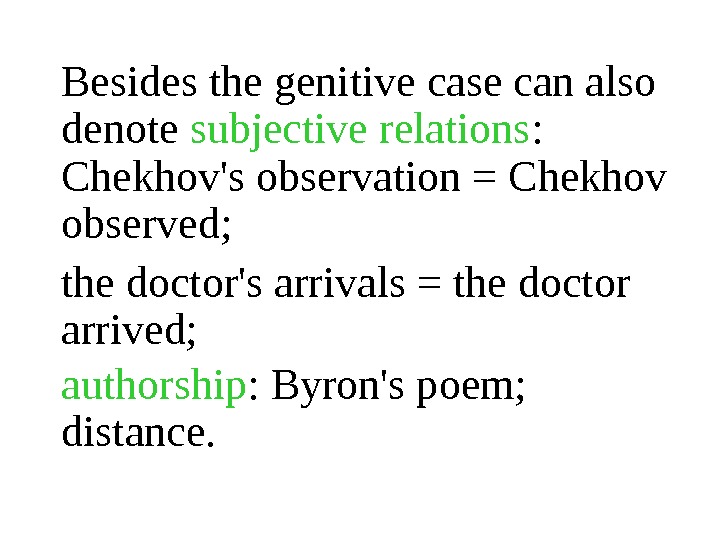
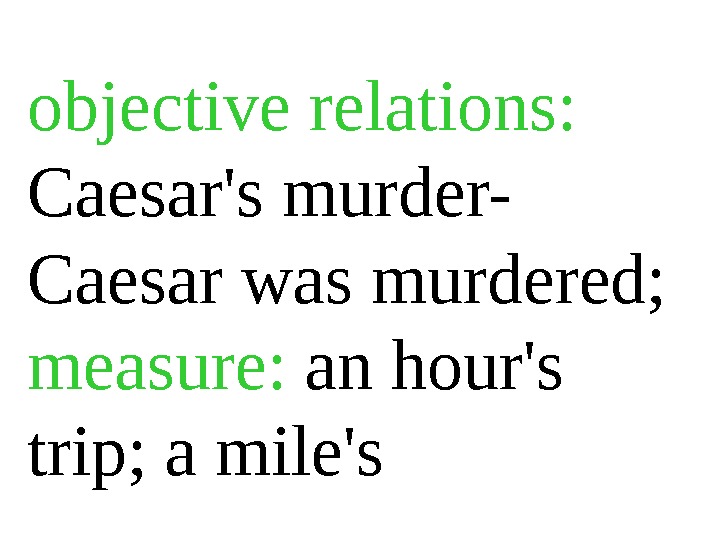



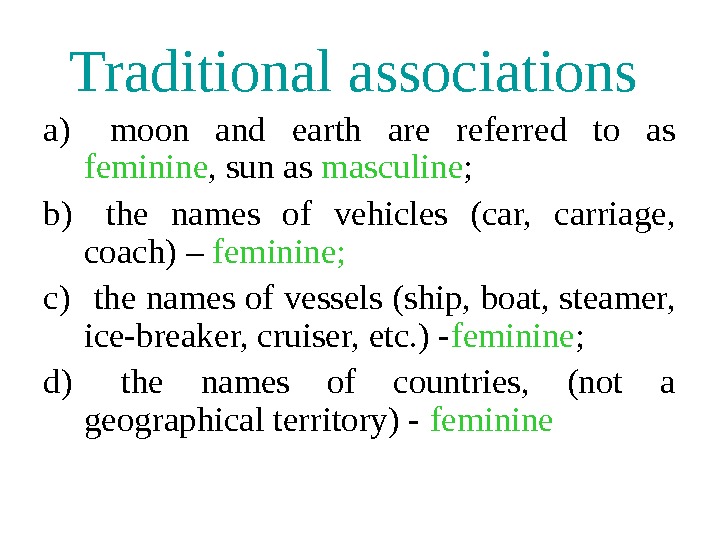
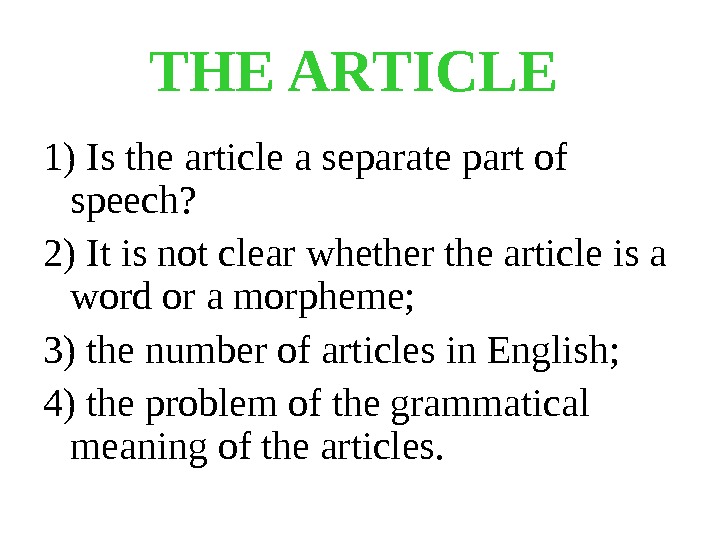
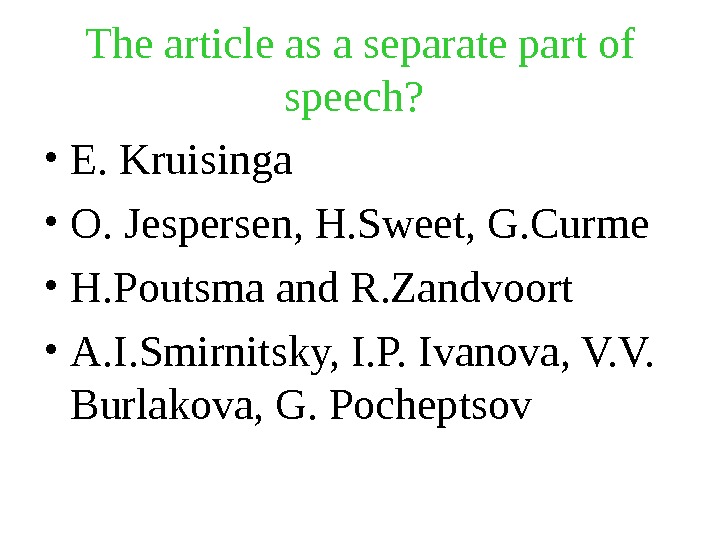




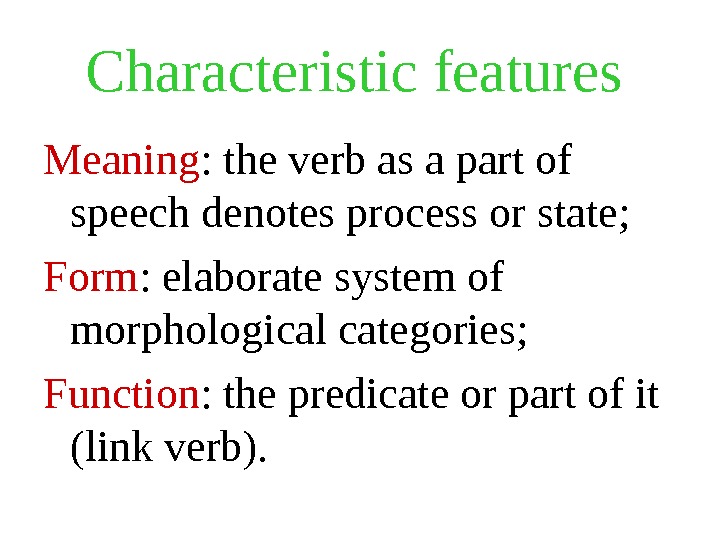
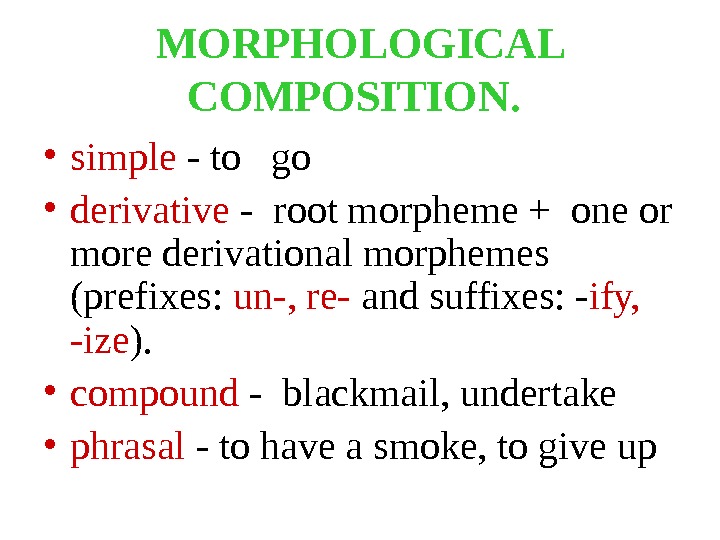
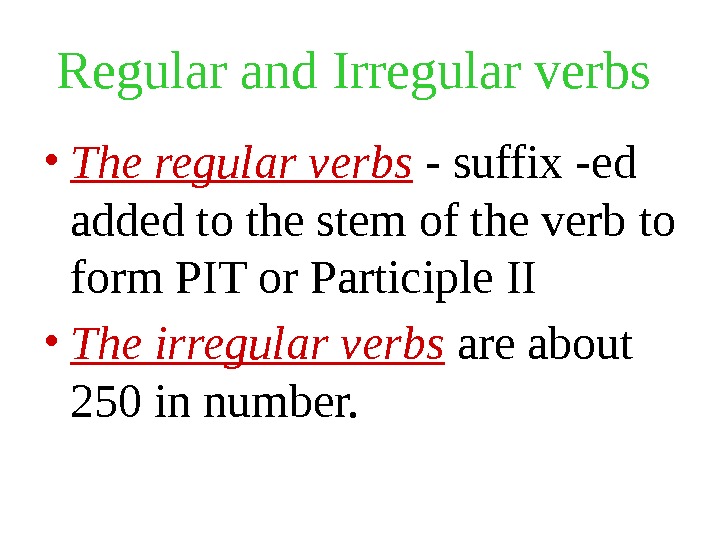

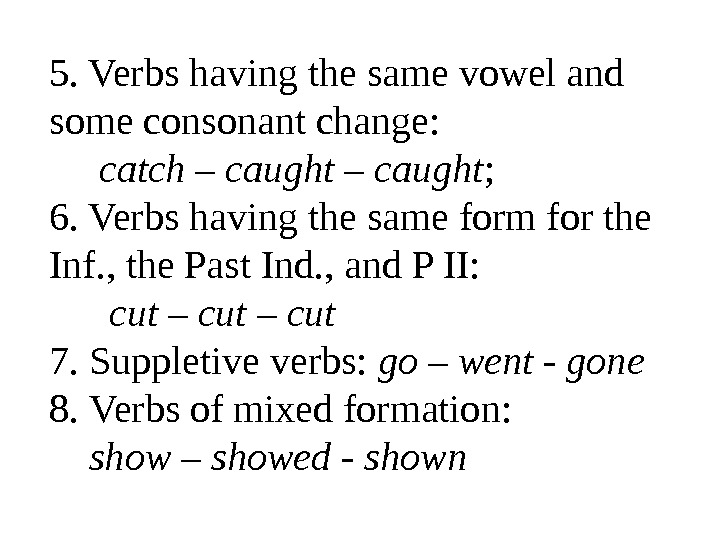
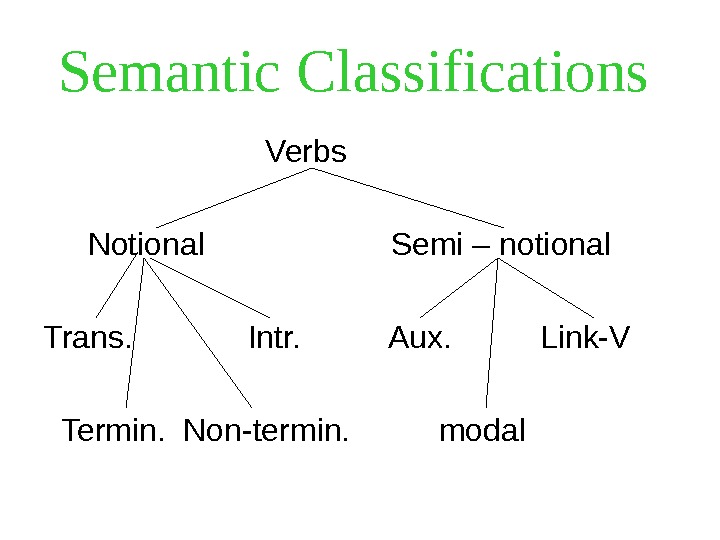


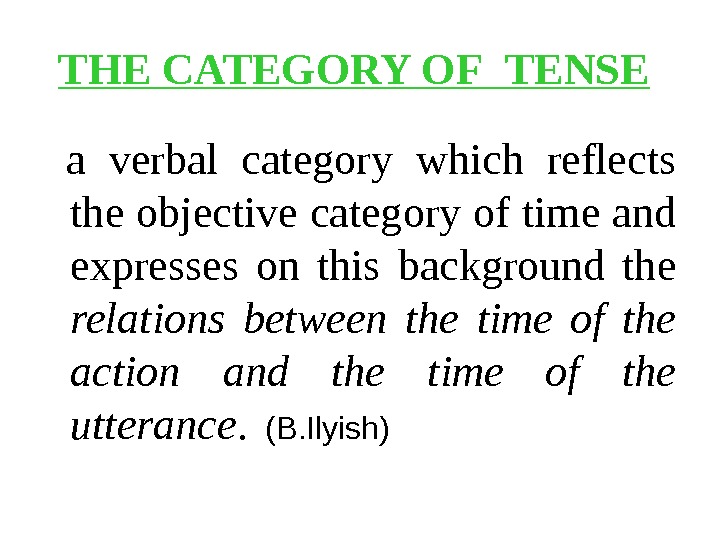
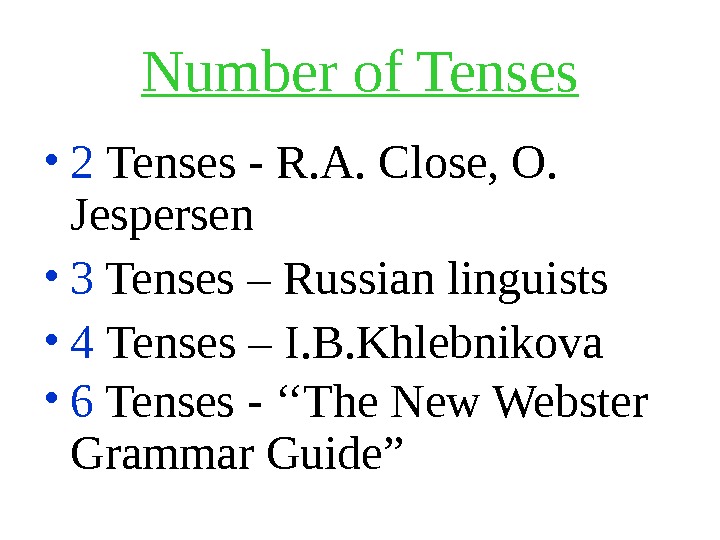


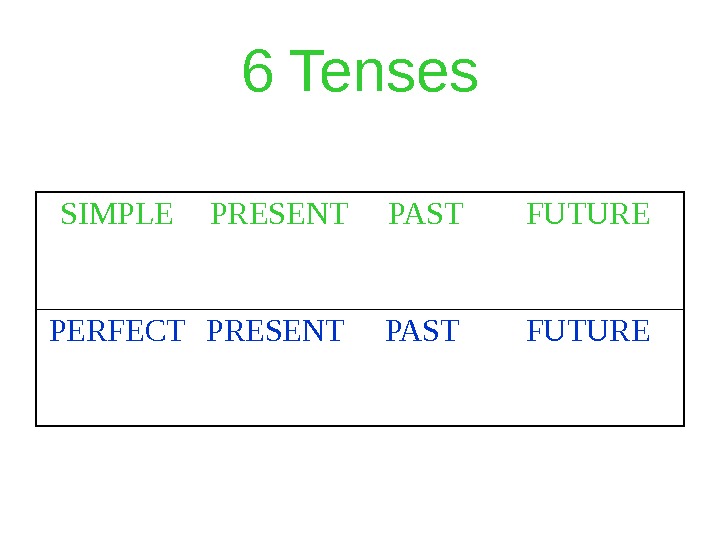



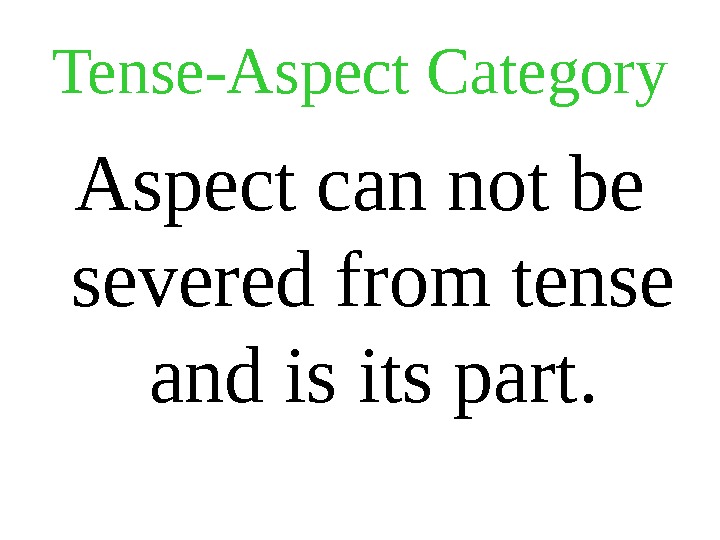

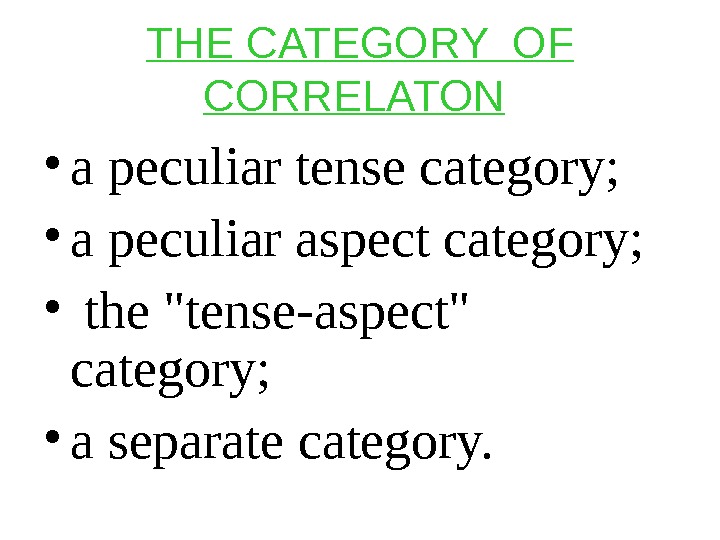
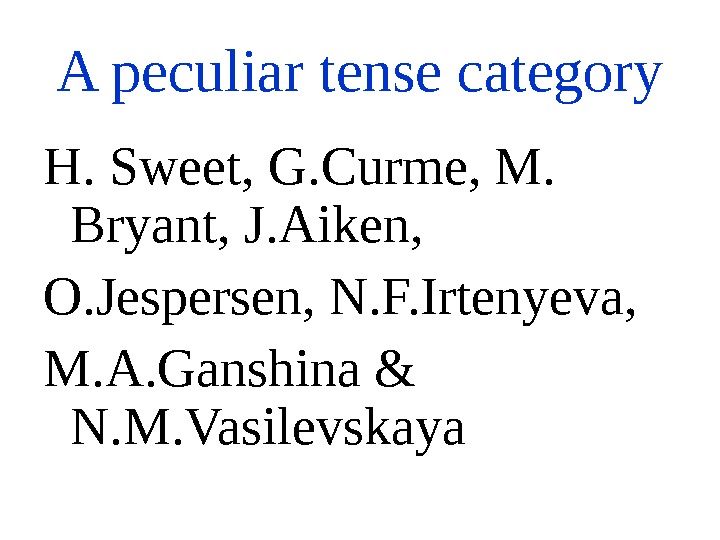
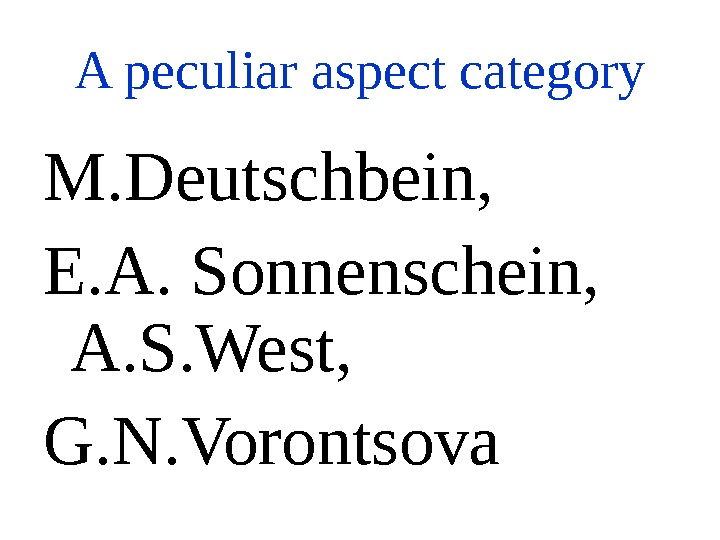
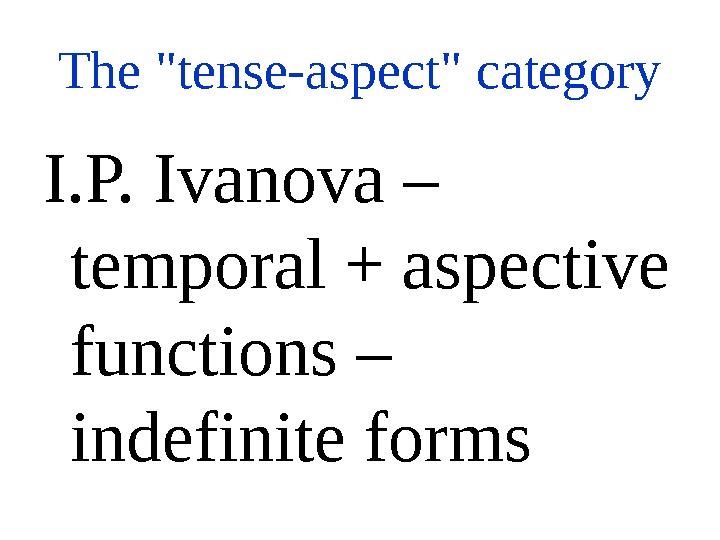
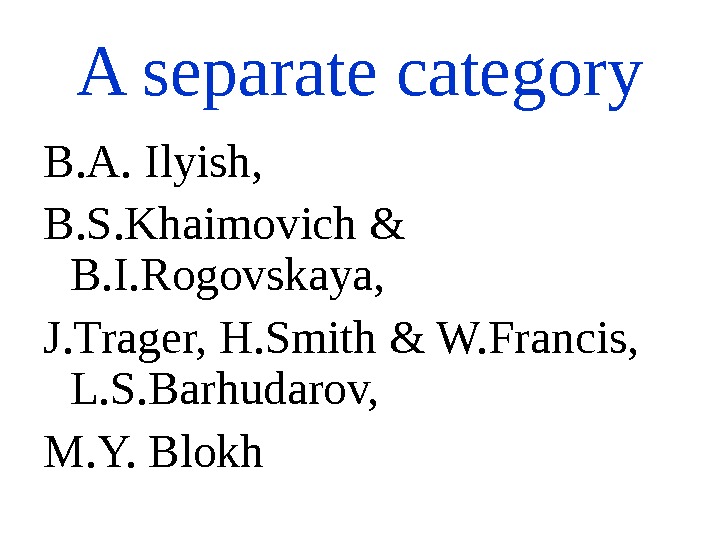
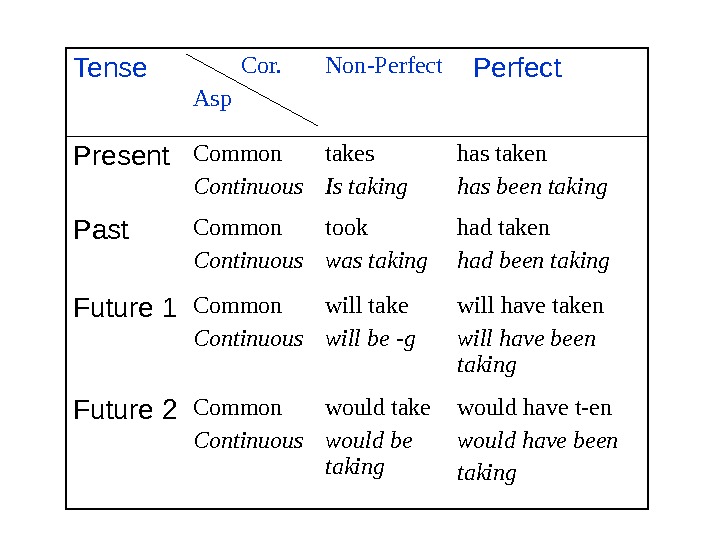

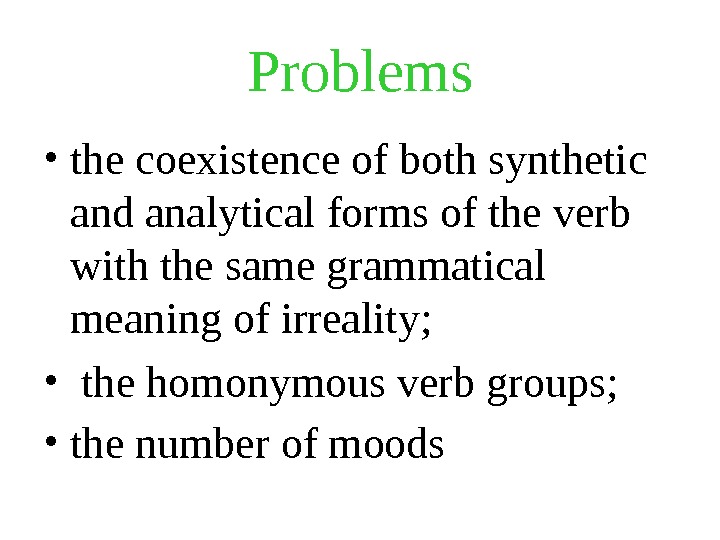
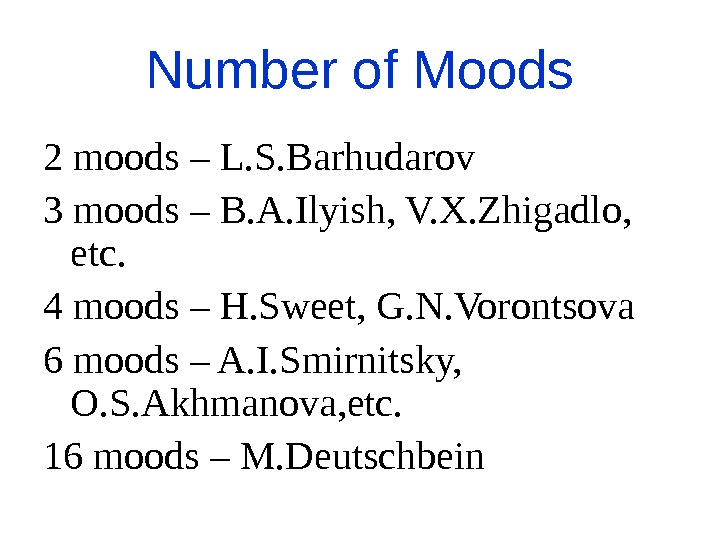


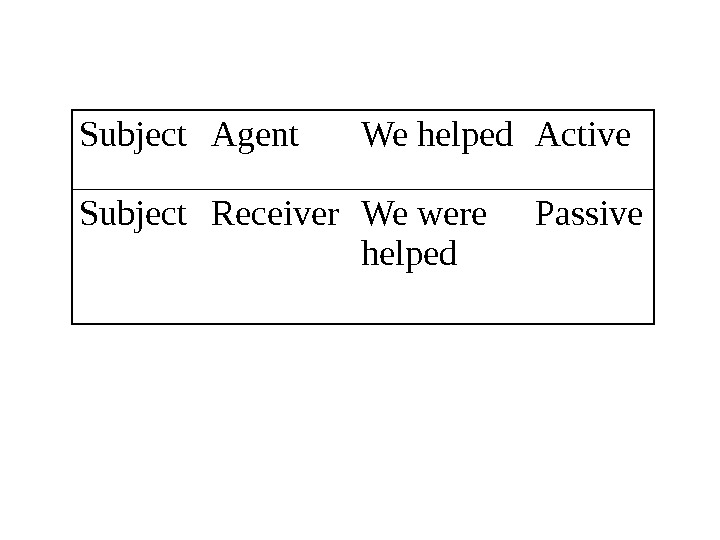
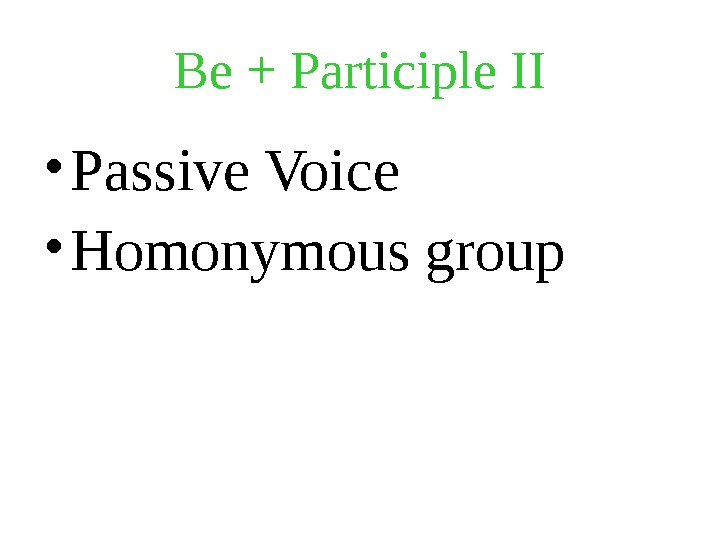
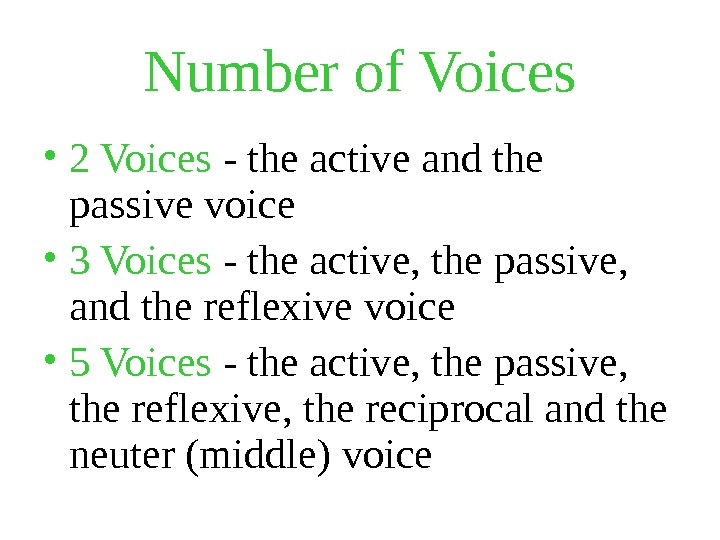
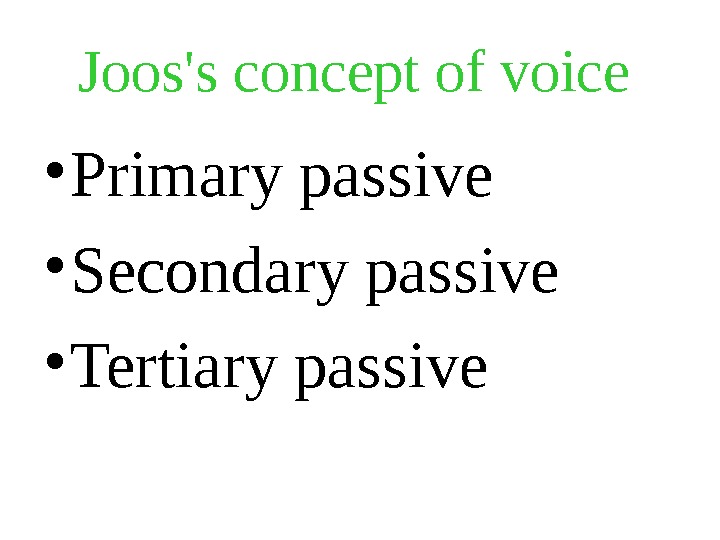

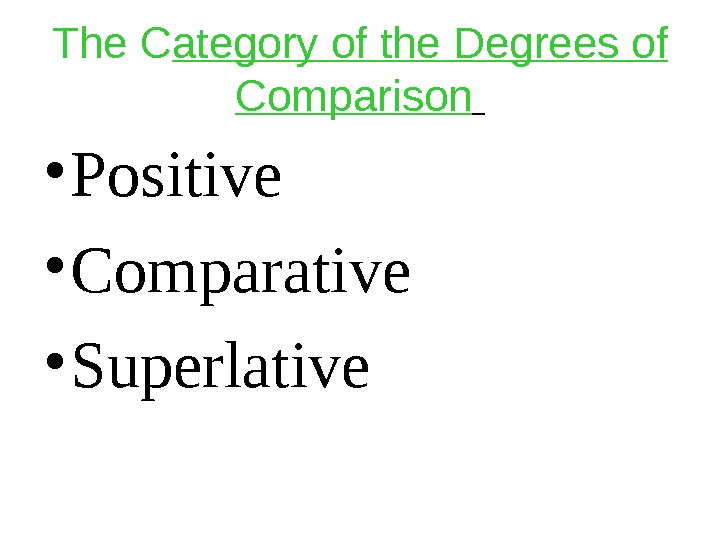

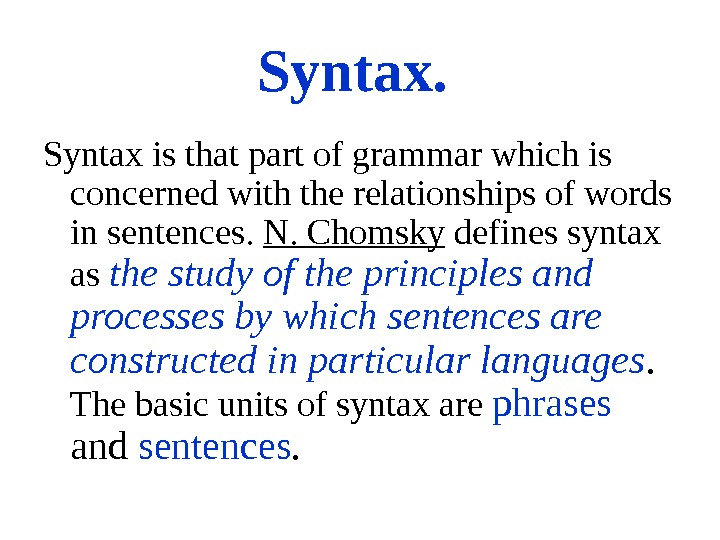
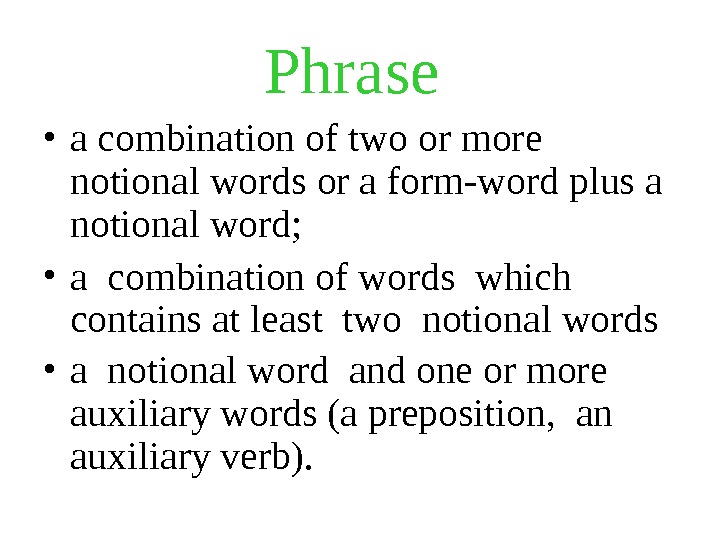




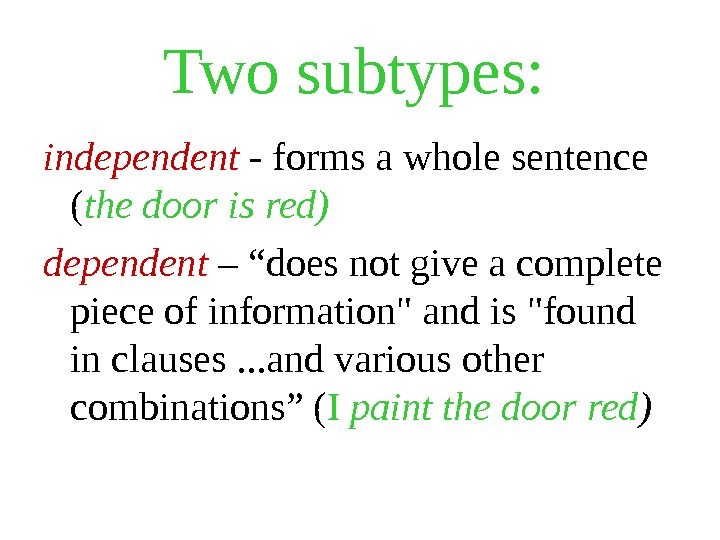
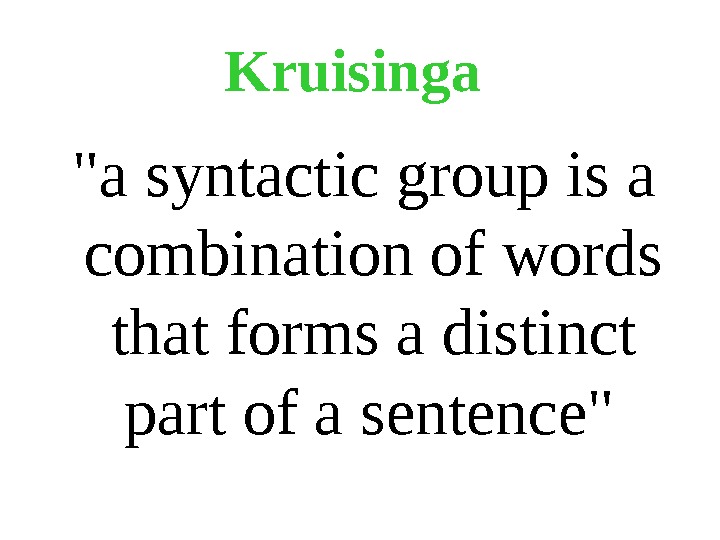


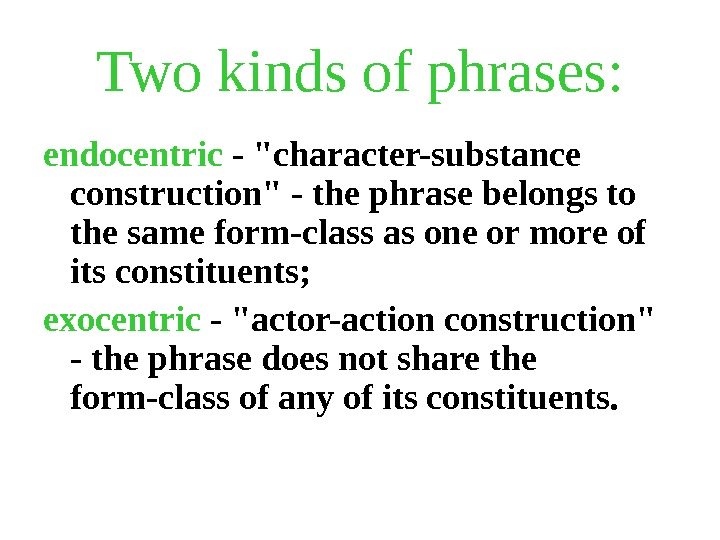
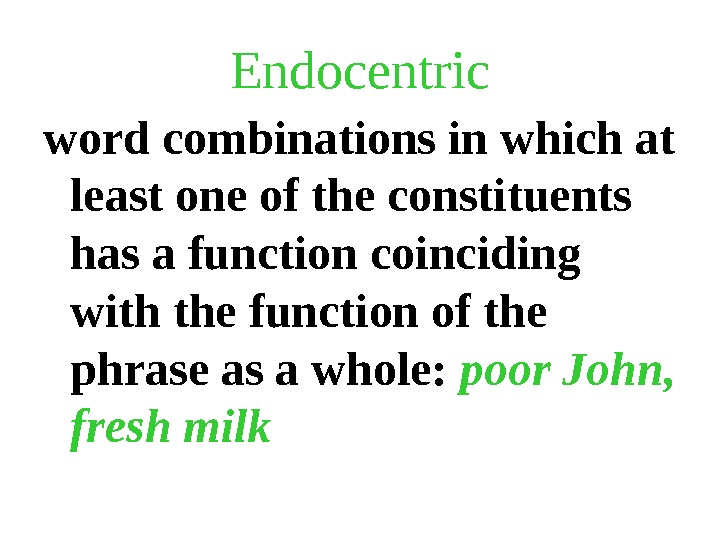

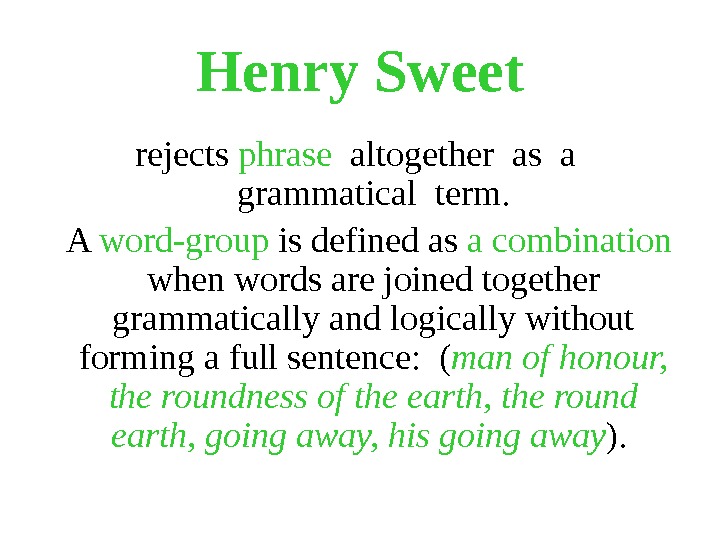

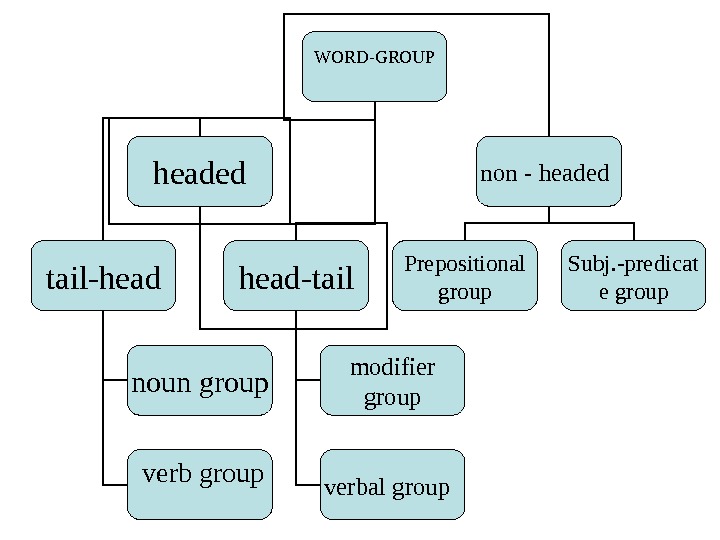

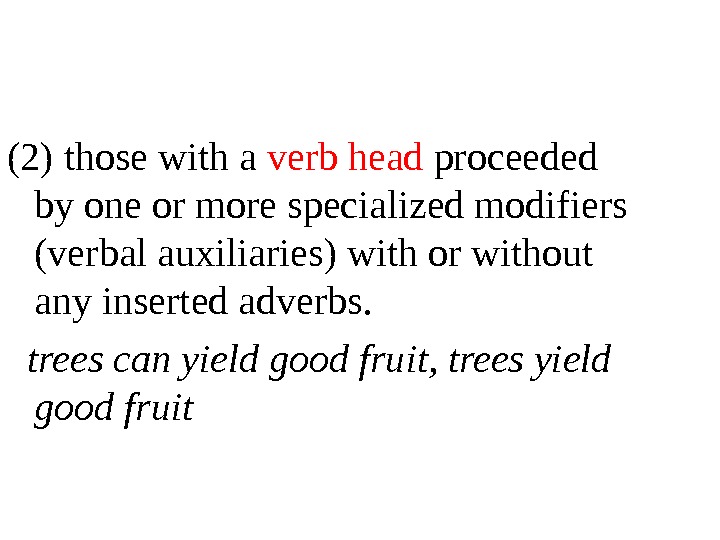
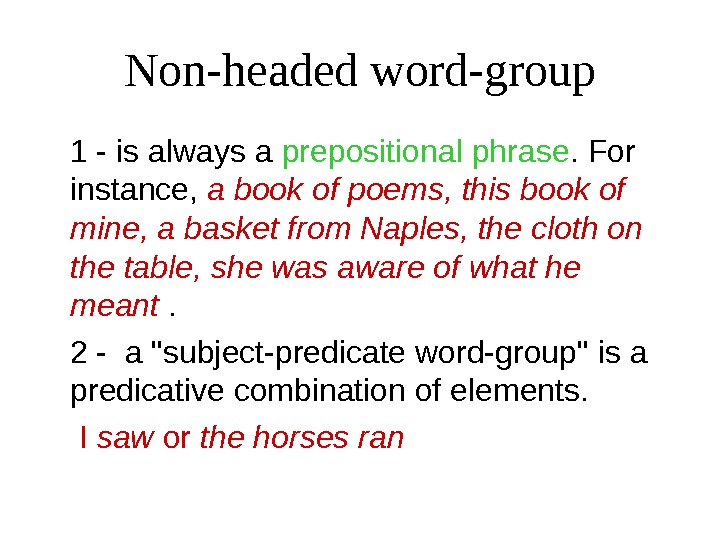
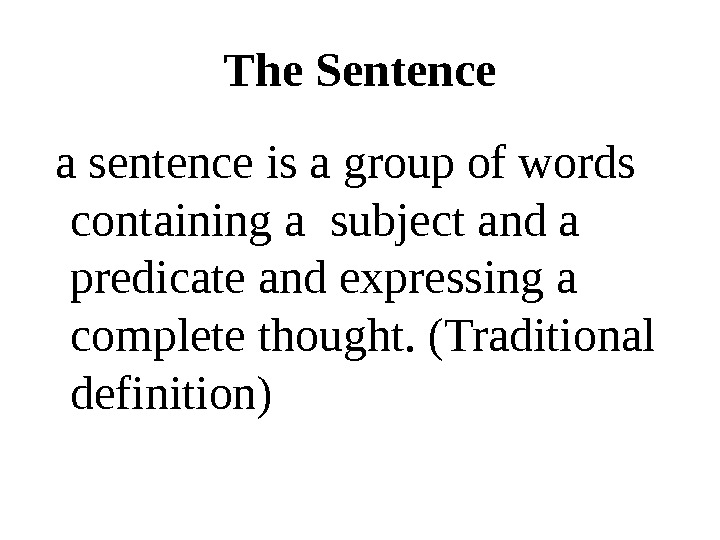

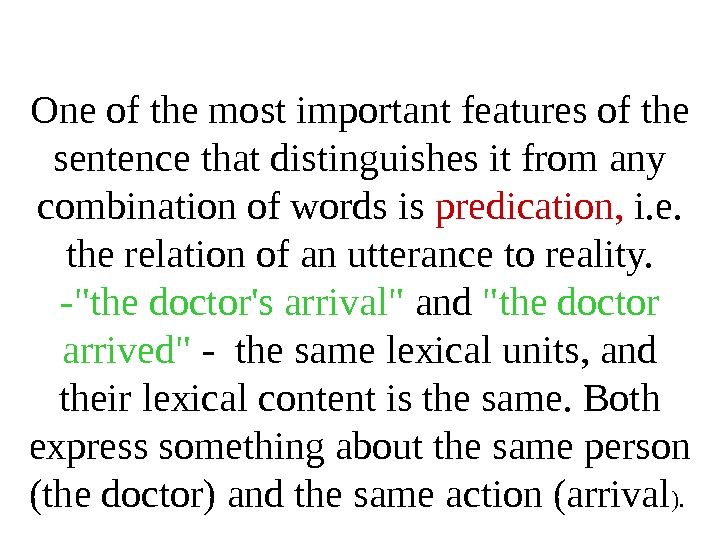



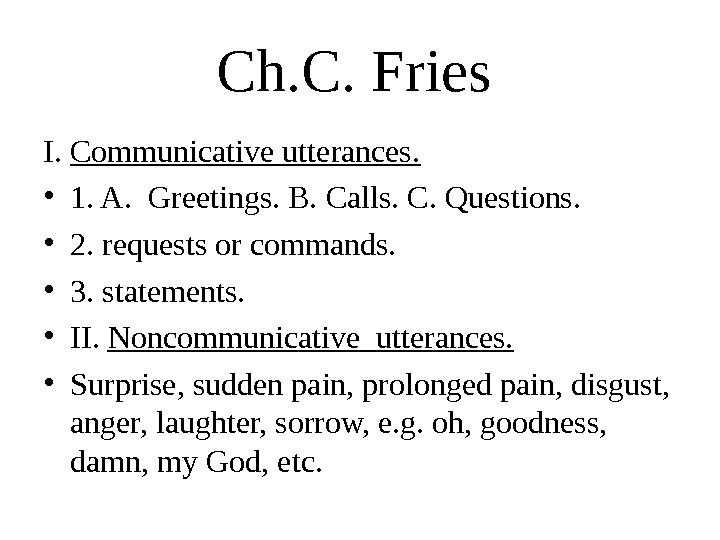
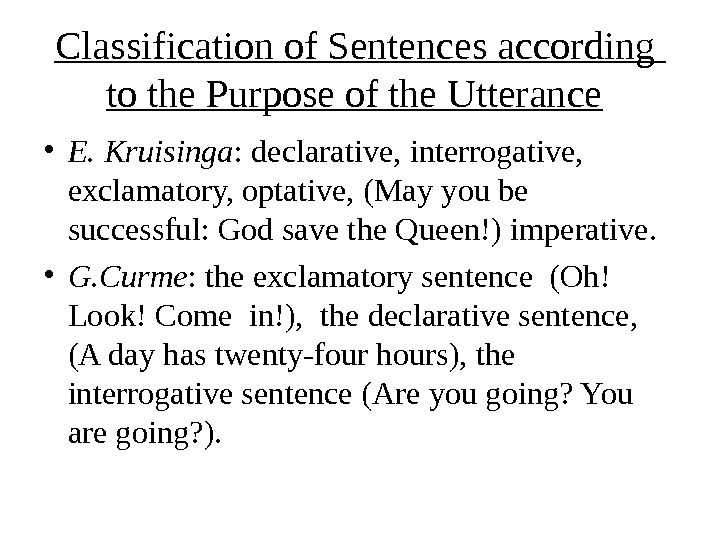

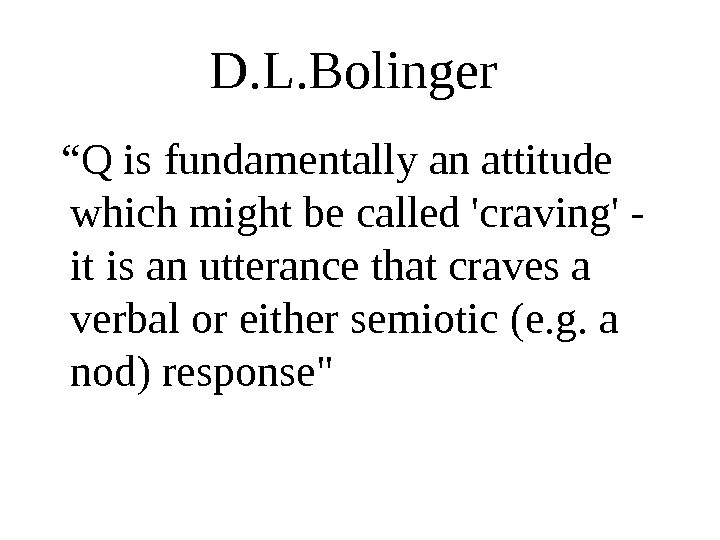

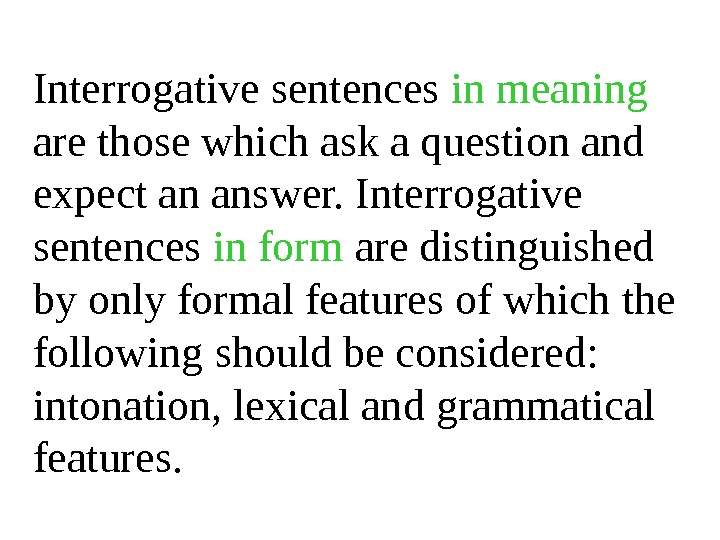


lectures_in_the_english_theoretical_grammar.ppt
- Размер: 589 Кб
- Количество слайдов: 180
Описание презентации LECTURES IN THE ENGLISH THEORETICAL GRAMMAR Angelina Vasilyevna по слайдам
 LECTURES IN THE ENGLISH THEORETICAL GRAMMAR Angelina Vasilyevna Bezrukova, Ass. Professor and Chair. Bld. 3, office 200. E-mail: alc@khsu. ru
LECTURES IN THE ENGLISH THEORETICAL GRAMMAR Angelina Vasilyevna Bezrukova, Ass. Professor and Chair. Bld. 3, office 200. E-mail: alc@khsu. ru
 INTRODUCTION • The Meanings of Grammar • The Grammatical Structure of Language. • Main Types of Grammar. • Methods of Linguistic Investigation.
INTRODUCTION • The Meanings of Grammar • The Grammatical Structure of Language. • Main Types of Grammar. • Methods of Linguistic Investigation.
 The 1 st thing meant by “grammar” is “the set of formal patterns in which the words of a language arranged in order to convey larger meanings. ”
The 1 st thing meant by “grammar” is “the set of formal patterns in which the words of a language arranged in order to convey larger meanings. ”
 The 2 nd sense in which the people use the word “grammar” is linguistic etiquette”. The word “grammar” to the ordinary person in English speaking countries has the meaning of “good or bad English”.
The 2 nd sense in which the people use the word “grammar” is linguistic etiquette”. The word “grammar” to the ordinary person in English speaking countries has the meaning of “good or bad English”.
 The 3 -d meaning of grammar is the branch of linguistic science which is concerned with the description, analysis, and formularization of formal language patterns.
The 3 -d meaning of grammar is the branch of linguistic science which is concerned with the description, analysis, and formularization of formal language patterns.
 So the 3 meanings of the term “grammar” are: Grammar I – a form of behavior; Grammar II – a branch of etiquette; Grammar III — a field of study, a science.
So the 3 meanings of the term “grammar” are: Grammar I – a form of behavior; Grammar II – a branch of etiquette; Grammar III — a field of study, a science.
 Grammar as a branch of linguistic science studies the grammatical structure of a language. The term “ structure ” suggests an inherent similarity between all levels of linguistic organization. The grammatical structure exists as an objective reality and does not depend on the will of people.
Grammar as a branch of linguistic science studies the grammatical structure of a language. The term “ structure ” suggests an inherent similarity between all levels of linguistic organization. The grammatical structure exists as an objective reality and does not depend on the will of people.
 Basic principles Culture of the community A set of language behavior patterns Analysis and Description conform to requirements
Basic principles Culture of the community A set of language behavior patterns Analysis and Description conform to requirements
 These are : (1) simplicity, (2) consistency, (3) completeness, and (4) usefulness for predicting the behavior of phenomena
These are : (1) simplicity, (2) consistency, (3) completeness, and (4) usefulness for predicting the behavior of phenomena
 “ Linguistic Star ”
“ Linguistic Star ”
 The levels of Language Structure. LEVELS UNITS F. TYPE P. OF L. LD S-PROP. S-GR. S TEXT TL PR-IC S-CE PRED. SYNTAX GR. PHRASE NOMIN. PH. , SYN GR, LX LEXEM. WORD NOMIN. MPH. , LX GR, LX MORPH. C. OF W. MORPH. GR. PHONE. PHON. DIFFER. PHON.
The levels of Language Structure. LEVELS UNITS F. TYPE P. OF L. LD S-PROP. S-GR. S TEXT TL PR-IC S-CE PRED. SYNTAX GR. PHRASE NOMIN. PH. , SYN GR, LX LEXEM. WORD NOMIN. MPH. , LX GR, LX MORPH. C. OF W. MORPH. GR. PHONE. PHON. DIFFER. PHON.
 The basic units of language structure are: • the phoneme, • the morpheme, • the word, • the phrase, and • the sentence.
The basic units of language structure are: • the phoneme, • the morpheme, • the word, • the phrase, and • the sentence.
 The basic units ______________________________ Text ___________________________ Sentence What feeling did you experience? — Awe _______________________ Phrase / Word combination _____________________ Word awe ________________ Morpheme aw-ful _____________ Phoneme [o: ] ___________
The basic units ______________________________ Text ___________________________ Sentence What feeling did you experience? — Awe _______________________ Phrase / Word combination _____________________ Word awe ________________ Morpheme aw-ful _____________ Phoneme [o: ] ___________
 A grammatical category (GC) Grammatical categories may be defined as generalized grammatical meanings, characteristic of a certain language, that are expressed by changes in the forms of words and combinations of words in sentences.
A grammatical category (GC) Grammatical categories may be defined as generalized grammatical meanings, characteristic of a certain language, that are expressed by changes in the forms of words and combinations of words in sentences.
 • The notion of GC applies to the plane of content of morphological paradigmatic units ; • It refers to grammatical meaning as a general notion; • It does not nominate things but expresses relations, that is why it has to be studied in terms of oppositions ; • GCs of a language represent a realization of universal categories produced by human thinking in a set of interrelated forms organized in oppositions; • GCs are not uniform ; they vary in accordance with the part of speech they belong to and the meaning they express; • The expression of GCs in a language is based upon close interrelation between their forms (exponents) and the meaning they convey.
• The notion of GC applies to the plane of content of morphological paradigmatic units ; • It refers to grammatical meaning as a general notion; • It does not nominate things but expresses relations, that is why it has to be studied in terms of oppositions ; • GCs of a language represent a realization of universal categories produced by human thinking in a set of interrelated forms organized in oppositions; • GCs are not uniform ; they vary in accordance with the part of speech they belong to and the meaning they express; • The expression of GCs in a language is based upon close interrelation between their forms (exponents) and the meaning they convey.
 TYPES OF GRAMMAR • Prescriptive Grammar • Descriptive grammar • Contrastive grammar • Historical grammar • Comparative grammar • General grammar • Functional grammar • Structural grammar • Transformational generative grammar
TYPES OF GRAMMAR • Prescriptive Grammar • Descriptive grammar • Contrastive grammar • Historical grammar • Comparative grammar • General grammar • Functional grammar • Structural grammar • Transformational generative grammar
 Nonsense ‘ Twas brillig, and the slithy toves Did gyre and gimble in the wabe; All mymsy were the borogoves, And the mome raths outgrabe. ( L. Carrall)
Nonsense ‘ Twas brillig, and the slithy toves Did gyre and gimble in the wabe; All mymsy were the borogoves, And the mome raths outgrabe. ( L. Carrall)
 Translations Варкалось. Хливкие шорьки Пырялись по наве, И хрюкотали зелюки, Как мюмзики в мове. (Н. Демурова)
Translations Варкалось. Хливкие шорьки Пырялись по наве, И хрюкотали зелюки, Как мюмзики в мове. (Н. Демурова)
 Сверкалось. Скойкие сюды Волчились у развел. Дрожали в лужасе грозды, И крюх засвирепел. (Вл. Орел)
Сверкалось. Скойкие сюды Волчились у развел. Дрожали в лужасе грозды, И крюх засвирепел. (Вл. Орел)
 Methods of Linguistic Investigation: the Reed-Kellog diagrams The sentence The Diagram Horses run. Horses │ run. He soon arrived. He │arrived. The two men left men│ left for the garage.
Methods of Linguistic Investigation: the Reed-Kellog diagrams The sentence The Diagram Horses run. Horses │ run. He soon arrived. He │arrived. The two men left men│ left for the garage.
 The sentence type subject + verb + object Bakers │ make bread • The rancher sold the (horse). Rancher │ sold | horse. • We saw the (clerk) over the counter. We │ saw | clerk.
The sentence type subject + verb + object Bakers │ make bread • The rancher sold the (horse). Rancher │ sold | horse. • We saw the (clerk) over the counter. We │ saw | clerk.
 A prepositional phrase He brought the horse to town. He │ brought ׀ horse. to town
A prepositional phrase He brought the horse to town. He │ brought ׀ horse. to town
 Subject + Verb + Indirect object + direct object He gave the dog a bone. He │ gave ׀ bone dog He gave a bone to the dog He │ gave ׀ bone to dog
Subject + Verb + Indirect object + direct object He gave the dog a bone. He │ gave ׀ bone dog He gave a bone to the dog He │ gave ׀ bone to dog
 Subject + linking verb + N/Adj/Adv a) The horse seems tired. Horse │ seems \ tired. b) John is busy. John │ is \ busy. c) My father is an engineer. Father │ is \ engineer. d) John became an architect. John │ became \ architect.
Subject + linking verb + N/Adj/Adv a) The horse seems tired. Horse │ seems \ tired. b) John is busy. John │ is \ busy. c) My father is an engineer. Father │ is \ engineer. d) John became an architect. John │ became \ architect.
 The next diagram feature is the line slanted to the right • They named him president. They │ named / president ׀ him. • The teacher considered him stupid. Teacher │ considered / stupid ׀ him
The next diagram feature is the line slanted to the right • They named him president. They │ named / president ׀ him. • The teacher considered him stupid. Teacher │ considered / stupid ׀ him
 Modifiers are slung below the line The three new hounds quickly found the scent. Hounds │ found ׀ scent the three new quickly the
Modifiers are slung below the line The three new hounds quickly found the scent. Hounds │ found ׀ scent the three new quickly the
 The plot was clear before the beginning of the first commercial Plot │ was \ clear the before beginning the of commercial the first
The plot was clear before the beginning of the first commercial Plot │ was \ clear the before beginning the of commercial the first
 Analysis by Immediate Constituents Usually the train comes on time. Train │ comes______ the usually on time Usually | the train comes on time. Modification
Analysis by Immediate Constituents Usually the train comes on time. Train │ comes______ the usually on time Usually | the train comes on time. Modification
 Modification Most of the time | the snow melts within a day When she heard that, | she slammed the door.
Modification Most of the time | the snow melts within a day When she heard that, | she slammed the door.
 Predication • The man | walked in. • The old woman in the gray suit | walked over to the counter
Predication • The man | walked in. • The old woman in the gray suit | walked over to the counter
 Example Usually he walked Predication Modification
Example Usually he walked Predication Modification
 A structure of subordination whenever he │ comes to town Predication Subordination Subordinating conjunctions are: after, although, because, before, until, since, after, whenever
A structure of subordination whenever he │ comes to town Predication Subordination Subordinating conjunctions are: after, although, because, before, until, since, after, whenever
 Prepositional Phrase in │ the car that John bought Subordination to │ come out of practice Subordination
Prepositional Phrase in │ the car that John bought Subordination to │ come out of practice Subordination
 A Noun Phrase 1 The old red car │ in the garage with the Modification rusted cylinders Modification
A Noun Phrase 1 The old red car │ in the garage with the Modification rusted cylinders Modification
 Noun Phrase 2 The old red car in the garage │ with the new cement floor Modification Subordination Modification
Noun Phrase 2 The old red car in the garage │ with the new cement floor Modification Subordination Modification
 Noun Phrase 3 the old red │ car in the garage Modification Modifucation
Noun Phrase 3 the old red │ car in the garage Modification Modifucation
 Pre-Verbal Modifiers quickly │ ran to the house modification
Pre-Verbal Modifiers quickly │ ran to the house modification
 Modifiers after the verb usually awoke │ when he heard her voice Modification
Modifiers after the verb usually awoke │ when he heard her voice Modification
 A complement of the verb John hit the ball. He gave John the ball A complement is a word or phrase that completes the meaning of the verb
A complement of the verb John hit the ball. He gave John the ball A complement is a word or phrase that completes the meaning of the verb
 Complements = modifiers Gave │ John the ball complementation
Complements = modifiers Gave │ John the ball complementation
 Hit │ the ball hard Complementation Modification
Hit │ the ball hard Complementation Modification
 The Sentence Diagram This car was built by union │ labor Modification Subordination Modification Predication
The Sentence Diagram This car was built by union │ labor Modification Subordination Modification Predication
 The first of the men left his jacket in the car
The first of the men left his jacket in the car
 Transformational Generative Grammar (TGG) Grammar is a set of rules forming sentences. (N. Chomsky) A grammar produces or generates sentences, hence the term generative.
Transformational Generative Grammar (TGG) Grammar is a set of rules forming sentences. (N. Chomsky) A grammar produces or generates sentences, hence the term generative.
 The term ‘ transformation’ is borrowed from mathematics where it refers to a process of altering the form of an expression without altering its value. The language-generative rules are summarized in symbolic formulas.
The term ‘ transformation’ is borrowed from mathematics where it refers to a process of altering the form of an expression without altering its value. The language-generative rules are summarized in symbolic formulas.
 Sentence structure S → NP + VP VP → Aux + MV { V } MV → { be + Pred } Vint. V → Vtr. + NP Vcomp. + Comp.
Sentence structure S → NP + VP VP → Aux + MV { V } MV → { be + Pred } Vint. V → Vtr. + NP Vcomp. + Comp.
 The man hit the ball. 1. S → NP +VP 2. VP → Vt +NP 3. NP → Art + N 4. Vt → hit 5. Art → the 6. N → man, ball
The man hit the ball. 1. S → NP +VP 2. VP → Vt +NP 3. NP → Art + N 4. Vt → hit 5. Art → the 6. N → man, ball
 K ernel sentences are the basic, elementary sentences of the language, the stuff from which all else is made. (P. Roberts) Kernal sentences are simple declarative sentences with the verb in the active voice which form the backbone of the language.
K ernel sentences are the basic, elementary sentences of the language, the stuff from which all else is made. (P. Roberts) Kernal sentences are simple declarative sentences with the verb in the active voice which form the backbone of the language.
 Patterns of kernel sentences 1. Nv. V– John came. 2. Nv. VPN – John looked at Mary 3. Nv. VN – John saw Mary. 4. N is N – John is a teacher 5. N is A – John is angry 6. N is PN – John is in bed 7. N is D – John is out
Patterns of kernel sentences 1. Nv. V– John came. 2. Nv. VPN – John looked at Mary 3. Nv. VN – John saw Mary. 4. N is N – John is a teacher 5. N is A – John is angry 6. N is PN – John is in bed 7. N is D – John is out
 Transforms are all other sentences which are derived from kernel sentences by means of transformations. Transforms retain their grammatical relations, but have an additional grammatical meaning of their own. For example, the sentence “Is he a student? ” in a transform derived from the kernel sentence “He is a student”.
Transforms are all other sentences which are derived from kernel sentences by means of transformations. Transforms retain their grammatical relations, but have an additional grammatical meaning of their own. For example, the sentence “Is he a student? ” in a transform derived from the kernel sentence “He is a student”.
 Cases of structural homonymy “ John is easy to please. ” “ John is eager to please”
Cases of structural homonymy “ John is easy to please. ” “ John is eager to please”
 John is eager to please • John is eager to V → John is eager to please (X) • John pleases X
John is eager to please • John is eager to V → John is eager to please (X) • John pleases X
 John is easy to please. • It is easy → It is easy (for X) to please John. → John is easy to please. • X pleases John
John is easy to please. • It is easy → It is easy (for X) to please John. → John is easy to please. • X pleases John
 “ Flying planes can be dangerous” • Planes fly. → Flying planes can be dangerous. • They are dangerous. • He flies planes. → Flying planes can be dangerous. • This is dangerous
“ Flying planes can be dangerous” • Planes fly. → Flying planes can be dangerous. • They are dangerous. • He flies planes. → Flying planes can be dangerous. • This is dangerous
 MORPHOLOGY AND SYNTAX Morphology is defined as that part of grammar which treats of the parts of speech and their inflexion, that is: the forms of tense, mood, etc. of verbs, the forms of degrees of comparison of adjectives, etc.
MORPHOLOGY AND SYNTAX Morphology is defined as that part of grammar which treats of the parts of speech and their inflexion, that is: the forms of tense, mood, etc. of verbs, the forms of degrees of comparison of adjectives, etc.
 Syntax is usually defined as that part of grammar, which treats of the rules according to which words are connected in the sentence, and also of various types of sentences, their structure and meaning.
Syntax is usually defined as that part of grammar, which treats of the rules according to which words are connected in the sentence, and also of various types of sentences, their structure and meaning.
 M orphemes — the smallest meaningful elements into which words can be analyzed Grammatical morphemes are scarce in English due to the prevalence of analytical or zero ending formation.
M orphemes — the smallest meaningful elements into which words can be analyzed Grammatical morphemes are scarce in English due to the prevalence of analytical or zero ending formation.
 form-building (morphological) morphemes (e. g. : — ed of the Past) as opposed to word-building (lexical) ones (e. g. : — ment in government, -less in jobless )
form-building (morphological) morphemes (e. g. : — ed of the Past) as opposed to word-building (lexical) ones (e. g. : — ment in government, -less in jobless )
 I. B. Khlebnikova suggests theory according to which the morphemes always form part of a grammeme (word-form). A form-building morpheme may be defined as an element of the word which signals the kind of grammatical meaning attached to it by the presence of the morpheme.
I. B. Khlebnikova suggests theory according to which the morphemes always form part of a grammeme (word-form). A form-building morpheme may be defined as an element of the word which signals the kind of grammatical meaning attached to it by the presence of the morpheme.
 The morpheme itself has a purely relational grammatical meaning which is revealed only by contrast with some other morpheme or grammeme which exposes a contrastive grammatical meaning. A morpheme as a unit of grammar is an exponent of a grammatical category ( or grammatical meaning ).
The morpheme itself has a purely relational grammatical meaning which is revealed only by contrast with some other morpheme or grammeme which exposes a contrastive grammatical meaning. A morpheme as a unit of grammar is an exponent of a grammatical category ( or grammatical meaning ).
 The term ‘ grammeme ’ presents an isolated unit, not part of the word. It is a carrier of grammatical information. When we speak of a word as a grammeme, we concentrate on the kind of grammatical information it carries, e. g. : the grammeme speaks shows the Present Tense 3 d person singular.
The term ‘ grammeme ’ presents an isolated unit, not part of the word. It is a carrier of grammatical information. When we speak of a word as a grammeme, we concentrate on the kind of grammatical information it carries, e. g. : the grammeme speaks shows the Present Tense 3 d person singular.
 PARTS OF SPEECH • Greek grammarians — 3 parts of speech — names, sayings, and joinings or linkings. • Latin grammarian Varro — 4 parts of speech : words with cases (nouns), words with tenses (verbs), wor ds with both cases and tenses (participles) and words with neither cases nor tenses (particles).
PARTS OF SPEECH • Greek grammarians — 3 parts of speech — names, sayings, and joinings or linkings. • Latin grammarian Varro — 4 parts of speech : words with cases (nouns), words with tenses (verbs), wor ds with both cases and tenses (participles) and words with neither cases nor tenses (particles).
 The earliest English grammars • Parts of speech : • Declinable — nouns, pronouns, verbs and participles • Indeclinable — adverbs, prepositions, conjunctions and interjections
The earliest English grammars • Parts of speech : • Declinable — nouns, pronouns, verbs and participles • Indeclinable — adverbs, prepositions, conjunctions and interjections
 • Ben Jonson — the article as the 9 th part of speech. • J. Brightland — 4 parts of speech: names (i. e. nouns), qualities (i. e. adjectives), affirmations (i. e. verbs) and particles
• Ben Jonson — the article as the 9 th part of speech. • J. Brightland — 4 parts of speech: names (i. e. nouns), qualities (i. e. adjectives), affirmations (i. e. verbs) and particles
 H. Sweet Three main features characterizing the parts of speech, namely meaning, form and function,
H. Sweet Three main features characterizing the parts of speech, namely meaning, form and function,
 Two main groups declinable • noun-words : noun, noun-pronoun, noun-numeral, infini tive, gerund, • adjective-words : adjective, adjective-pronoun, adjective-numeral, participles. • verb : finite verb, verbals (infinitive, gerund, parti ciples)
Two main groups declinable • noun-words : noun, noun-pronoun, noun-numeral, infini tive, gerund, • adjective-words : adjective, adjective-pronoun, adjective-numeral, participles. • verb : finite verb, verbals (infinitive, gerund, parti ciples)
 indeclinable (particles): • adverb, • preposition, • conjunction, • interjection.
indeclinable (particles): • adverb, • preposition, • conjunction, • interjection.
 O. Jespersen 5 word-classes: • (1) Substantives (including proper nouns). • (2) Adjectives. • (3) Pronouns (including numerals and pronominal adverbs). • (4) Verbs (with doubts as to the inclusion of «verbids»). • (5) Particles
O. Jespersen 5 word-classes: • (1) Substantives (including proper nouns). • (2) Adjectives. • (3) Pronouns (including numerals and pronominal adverbs). • (4) Verbs (with doubts as to the inclusion of «verbids»). • (5) Particles
 “ The Three Ranks” Theory an extremely hot weather a furiously barking dog weather, dog — primary hot, barking — secondary extremely, furiously — tertiary
“ The Three Ranks” Theory an extremely hot weather a furiously barking dog weather, dog — primary hot, barking — secondary extremely, furiously — tertiary
 J. C. Nesfield’s grammar “ Words are classified according to the purpose that they are used for and every such class is called a Part of Speech. ”
J. C. Nesfield’s grammar “ Words are classified according to the purpose that they are used for and every such class is called a Part of Speech. ”
 (1) A Noun is a word used for naming some person or thing. (2) A Pronoun is a word used instead of a noun or noun-equivalent. (3) An Adjective is a word used to qualify a noun. (4) A Verb is a word used for saying some thing about some person or thing. (5) A Preposition is a word placed before a noun or noun-equivalent to show in what relation the person or thing denoted by the noun stands to something else.
(1) A Noun is a word used for naming some person or thing. (2) A Pronoun is a word used instead of a noun or noun-equivalent. (3) An Adjective is a word used to qualify a noun. (4) A Verb is a word used for saying some thing about some person or thing. (5) A Preposition is a word placed before a noun or noun-equivalent to show in what relation the person or thing denoted by the noun stands to something else.
 (6) A Conjunction is a word used to join words or phrases together, or one clause to another clause. (7) An Adverb is a word used to qualify any part of speech except a noun or pronouns. (8) An Interjection is a word or «sound” thrown into a sentence to express some feeling of the mind.
(6) A Conjunction is a word used to join words or phrases together, or one clause to another clause. (7) An Adverb is a word used to qualify any part of speech except a noun or pronouns. (8) An Interjection is a word or «sound” thrown into a sentence to express some feeling of the mind.
 Ch. Fries Parts of speech are » form-classes ” which are » functioning patterns » and they are distinguished by their «structural meaning» He distinguishes 4 form-classes (1, 2, 3, 4) and 15 function words (A. . 0).
Ch. Fries Parts of speech are » form-classes ” which are » functioning patterns » and they are distinguished by their «structural meaning» He distinguishes 4 form-classes (1, 2, 3, 4) and 15 function words (A. . 0).
 W ords of Class I : Frame A : The concert was good food coffee
W ords of Class I : Frame A : The concert was good food coffee
 Frame B : The clerk remembered the tax Husband food Woman coffee
Frame B : The clerk remembered the tax Husband food Woman coffee
 Frame C: The team went there. husband woman
Frame C: The team went there. husband woman
 WORDS OF CLASS II Class I Class II The___ is / was good _____ s are / were seems / seemed
WORDS OF CLASS II Class I Class II The___ is / was good _____ s are / were seems / seemed
 WORDS OF CLASS 3: class 3 1 2 3 (The) good ____(s) is / was good large large
WORDS OF CLASS 3: class 3 1 2 3 (The) good ____(s) is / was good large large
 WORDS OF CLASS 4: class class 3 1 2 3 4 (The) __ ____(s) is / was ____ there always
WORDS OF CLASS 4: class class 3 1 2 3 4 (The) __ ____(s) is / was ____ there always
 ‘ Function words’ • Group A : no, your, both, few, Jon’s, one, four, most, that, etc. • Group B : get, keep , etc. • Group C : not. • Group D : very good – quite, awfully, most, rather , etc. • Group E: and, but, or, not, nor, rather than
‘ Function words’ • Group A : no, your, both, few, Jon’s, one, four, most, that, etc. • Group B : get, keep , etc. • Group C : not. • Group D : very good – quite, awfully, most, rather , etc. • Group E: and, but, or, not, nor, rather than
 Group F : the position of at. Group G : do (does, did). Group H : there (in there is…). Group I : when (why, where, how ). Group J : whenever, so, and, but, since, etc. Group K : well, oh, now, why Group L : with yes and no. Group M : look, say, listen. Group N – please. Group O – let’s (let us).
Group F : the position of at. Group G : do (does, did). Group H : there (in there is…). Group I : when (why, where, how ). Group J : whenever, so, and, but, since, etc. Group K : well, oh, now, why Group L : with yes and no. Group M : look, say, listen. Group N – please. Group O – let’s (let us).
 The general current definition of parts of speech places them as lexico-grammatical word-classes which are characterized by a general abstract grammatical meaning expressed in certain grammatical markers.
The general current definition of parts of speech places them as lexico-grammatical word-classes which are characterized by a general abstract grammatical meaning expressed in certain grammatical markers.
 3 principles • meaning, • form, • function.
3 principles • meaning, • form, • function.
 Meaning “ the meaning common to all the words of the given class and constituting its essence. ”
Meaning “ the meaning common to all the words of the given class and constituting its essence. ”
 By form The morphological characteristics of a type of word is meant.
By form The morphological characteristics of a type of word is meant.
 By function the syntactical properties of a type of word are meant
By function the syntactical properties of a type of word are meant
 Notional and Functional P. of S. • Ilyish, B. A. • Kobrina, N. A. , Korneeva E. A. • Blokh, M. Y. • Ivanova, I. P. , B. B. Burlakova, and G. G. Pocheptsov
Notional and Functional P. of S. • Ilyish, B. A. • Kobrina, N. A. , Korneeva E. A. • Blokh, M. Y. • Ivanova, I. P. , B. B. Burlakova, and G. G. Pocheptsov
 NOUNS 1) the categorical meaning of substance («thingness»); 2) the changeable forms of number and case; 3) the substantive functions in the sentence
NOUNS 1) the categorical meaning of substance («thingness»); 2) the changeable forms of number and case; 3) the substantive functions in the sentence
 M. Y. Blokh: 4 subclasses Noun proper common count. uncount. animate inanimate human non-human
M. Y. Blokh: 4 subclasses Noun proper common count. uncount. animate inanimate human non-human
 Traditional semantic characteristics of all the nouns: Nouns common Proper count uncount Concrete Abstract material abstaract Animate Inanimate collect.
Traditional semantic characteristics of all the nouns: Nouns common Proper count uncount Concrete Abstract material abstaract Animate Inanimate collect.
 Morphological composition • Simple: one-root morpheme • Derived: one-root morph. + der. affixes • Compound: 2 or more stems
Morphological composition • Simple: one-root morpheme • Derived: one-root morph. + der. affixes • Compound: 2 or more stems
 Noun: Number. The category of number is expressed by the opposition of the plural form of the noun to the singular form of the noun. dog-dog s , clock-clock s , box-box es
Noun: Number. The category of number is expressed by the opposition of the plural form of the noun to the singular form of the noun. dog-dog s , clock-clock s , box-box es
 Noun: CASE. Grammatical case is the relation in which one noun (or pronoun) stands to some other word in the sentence, or the form of the noun (or pronoun) which shows that relation (C. E. Eckersley and J. M. Eckerslev’).
Noun: CASE. Grammatical case is the relation in which one noun (or pronoun) stands to some other word in the sentence, or the form of the noun (or pronoun) which shows that relation (C. E. Eckersley and J. M. Eckerslev’).
 Old English — 5 cases: • Nominative, • Vocative, • Accusitive, • Genetive and • Dative
Old English — 5 cases: • Nominative, • Vocative, • Accusitive, • Genetive and • Dative
 “ Theory of the positional cases». • The nominative case (subject to a verb: Rain falls. • The vocative case (address): Are you coming, m y friend? • The dative case (in direct object to a verb): I gave John a penny. • The accusative case (direct object and also object to a preposition): The man rode a fine horse.
“ Theory of the positional cases». • The nominative case (subject to a verb: Rain falls. • The vocative case (address): Are you coming, m y friend? • The dative case (in direct object to a verb): I gave John a penny. • The accusative case (direct object and also object to a preposition): The man rode a fine horse.
 “ Theory of prepositional cases» • the » dative case» (to + Noun, for + Noun) and • the » genitive » case (of + Noun). These prepositions, according to G. Curme, are «inflexional prepositions», i. e. grammatical elements equivalent to case-forms.
“ Theory of prepositional cases» • the » dative case» (to + Noun, for + Noun) and • the » genitive » case (of + Noun). These prepositions, according to G. Curme, are «inflexional prepositions», i. e. grammatical elements equivalent to case-forms.
 Limited case theory 2 cases in English, one of them featured and the other one unfeatured. H. Sweet, O. Jespersen, A. I. Smirnitsky, L. S. Barkhudarov and others.
Limited case theory 2 cases in English, one of them featured and the other one unfeatured. H. Sweet, O. Jespersen, A. I. Smirnitsky, L. S. Barkhudarov and others.
 • The common case is unmarked, it has no inflexion (zero inflection) and its meaning is very general. • The genitive case is marked by the apostrophe s ( ‘s ).
• The common case is unmarked, it has no inflexion (zero inflection) and its meaning is very general. • The genitive case is marked by the apostrophe s ( ‘s ).
 Genitive Case The main modifications of this meaning are: 1. The idea of belonging : John’s coat, Mary’s car; 2. Different kinds of relations, such as: a) relation of the whole to its parts : John’s leg; the cat’s tail; b) b) personal or social relations: John’s wife, John’s friend;
Genitive Case The main modifications of this meaning are: 1. The idea of belonging : John’s coat, Mary’s car; 2. Different kinds of relations, such as: a) relation of the whole to its parts : John’s leg; the cat’s tail; b) b) personal or social relations: John’s wife, John’s friend;
 Besides the genitive case can also denote subjective relations : Chekhov’s observation = Chekhov observed; the doctor’s arrivals = the doctor arrived; authorship : Byron’s poem; distance.
Besides the genitive case can also denote subjective relations : Chekhov’s observation = Chekhov observed; the doctor’s arrivals = the doctor arrived; authorship : Byron’s poem; distance.
 objective relations: Caesar’s murder- Caesar was murdered; measure: an hour’s trip; a mile’s
objective relations: Caesar’s murder- Caesar was murdered; measure: an hour’s trip; a mile’s
 Postpositional theory 1) The use of -‘s is optional (her brother’s, of her brother); 2) It is used with a limited group of nouns outside which it occurs very seldom. 3) ( ‘s ) is used both in the singular and in plural (child’s, children’s) which is not incident to case morphemes; and some other reasons.
Postpositional theory 1) The use of -‘s is optional (her brother’s, of her brother); 2) It is used with a limited group of nouns outside which it occurs very seldom. 3) ( ‘s ) is used both in the singular and in plural (child’s, children’s) which is not incident to case morphemes; and some other reasons.
 Noun: Gender J. C. Nesfield speaks of 4 genders in English: the Masculine (that denotes a male); the Feminine gender (one that denotes a female); the Common gender (one that denotes either sex); the Neuter gender (one that denotes neither sex, that is something without life).
Noun: Gender J. C. Nesfield speaks of 4 genders in English: the Masculine (that denotes a male); the Feminine gender (one that denotes a female); the Common gender (one that denotes either sex); the Neuter gender (one that denotes neither sex, that is something without life).
 Masculine and Feminine 3 different ways: 1) By a change of word : boy — girl; cock-hen; uncle-aunt; lord-lady • 2) By a change of ending : actor-actress; host-hostess; waiter-waitress. • Peculiar Changes of Ending: hero-heroine; wizard-witch; widower-widow. • 3) By placing a word before or after : He-goat; she-goat; land-lord; land-lady
Masculine and Feminine 3 different ways: 1) By a change of word : boy — girl; cock-hen; uncle-aunt; lord-lady • 2) By a change of ending : actor-actress; host-hostess; waiter-waitress. • Peculiar Changes of Ending: hero-heroine; wizard-witch; widower-widow. • 3) By placing a word before or after : He-goat; she-goat; land-lord; land-lady
 Traditional associations a) moon and earth are referred to as feminine , sun as masculine ; b) the names of vehicles (car, carriage, coach) – feminine; c) the names of vessels (ship, boat, steamer, ice-breaker, cruiser, etc. ) — feminine ; d) the names of countries, (not a geographical territory) — feminine
Traditional associations a) moon and earth are referred to as feminine , sun as masculine ; b) the names of vehicles (car, carriage, coach) – feminine; c) the names of vessels (ship, boat, steamer, ice-breaker, cruiser, etc. ) — feminine ; d) the names of countries, (not a geographical territory) — feminine
 THE ARTICLE 1) Is the article a separate part of speech? 2) It is not clear whether the article is a word or a morpheme; 3) the number of articles in English; 4) the problem of the grammatical meaning of the articles.
THE ARTICLE 1) Is the article a separate part of speech? 2) It is not clear whether the article is a word or a morpheme; 3) the number of articles in English; 4) the problem of the grammatical meaning of the articles.
 The article as a separate part of speech? • E. Kruisinga • O. Jespersen, H. Sweet, G. Curme • H. Poutsma and R. Zandvoort • A. I. Smirnitsky, I. P. Ivanova, V. V. Burlakova, G. Pocheptsov
The article as a separate part of speech? • E. Kruisinga • O. Jespersen, H. Sweet, G. Curme • H. Poutsma and R. Zandvoort • A. I. Smirnitsky, I. P. Ivanova, V. V. Burlakova, G. Pocheptsov
 Is the article a word or a morpheme? 1) A(n) and the are not devoid of lexical meaning as grammatical word-morphemes are. 2) Their meanings are not relative. The has the meaning of ‘definiteness’ not only when opposed to a(n): snow — the snow; books — the books.
Is the article a word or a morpheme? 1) A(n) and the are not devoid of lexical meaning as grammatical word-morphemes are. 2) Their meanings are not relative. The has the meaning of ‘definiteness’ not only when opposed to a(n): snow — the snow; books — the books.
 The number of articles • 3 articles : Indefinite, Definite and Zero • 2 articles : Definite and Indefinite
The number of articles • 3 articles : Indefinite, Definite and Zero • 2 articles : Definite and Indefinite
 The grammatical meaning 3 functions : morphological, syntactical and semantical. Morphologically it is used to determine a noun. Its syntactical function determining the left boarder of attributive word-combination. The main semantic function of the articles is the expression of the ‘theme-rheme’ division of the text.
The grammatical meaning 3 functions : morphological, syntactical and semantical. Morphologically it is used to determine a noun. Its syntactical function determining the left boarder of attributive word-combination. The main semantic function of the articles is the expression of the ‘theme-rheme’ division of the text.
 THE VERB. 1. ‘A verb is a word for saying something about some person or thing’; 2. ‘. . . the part of speech by which we are able to say what a person or animal or thing is or does or what is done to that animal, person or thing’; 3. ‘. . . the part of speech that predicates, assists in predication, asks a question and expresses a command. ‘ (C. E. Eckersley).
THE VERB. 1. ‘A verb is a word for saying something about some person or thing’; 2. ‘. . . the part of speech by which we are able to say what a person or animal or thing is or does or what is done to that animal, person or thing’; 3. ‘. . . the part of speech that predicates, assists in predication, asks a question and expresses a command. ‘ (C. E. Eckersley).
 Characteristic features Meaning : the verb as a part of speech denotes process or state; Form : elaborate system of morphological categories; Function : the predicate or part of it (link verb).
Characteristic features Meaning : the verb as a part of speech denotes process or state; Form : elaborate system of morphological categories; Function : the predicate or part of it (link verb).
 MORPHOLOGICAL COMPOSITION. • simple — to go • derivative — root morpheme + one or more derivational morphemes (prefixes: un-, re- and suffixes: — ify, -ize ). • compound — blackmail, undertake • phrasal — to have a smoke, to give up
MORPHOLOGICAL COMPOSITION. • simple — to go • derivative — root morpheme + one or more derivational morphemes (prefixes: un-, re- and suffixes: — ify, -ize ). • compound — blackmail, undertake • phrasal — to have a smoke, to give up
 Regular and Irregular verbs • The regular verbs — suffix -ed added to the stem of the verb to form PIT or Participle II • The irregular verbs are about 250 in number.
Regular and Irregular verbs • The regular verbs — suffix -ed added to the stem of the verb to form PIT or Participle II • The irregular verbs are about 250 in number.
 Irregular verbs: 8 groups 1. Verbs changing their root vowel : begin- began – begun 2. Verbs changing their root vowel in the past form : fall – fell – fallen 3. Verbs changing the root vowel to the same vowel: bite – bit — bitten 4. Verbs having the same vowel for the 2 -d and 3 -d: sell – sold — sold
Irregular verbs: 8 groups 1. Verbs changing their root vowel : begin- began – begun 2. Verbs changing their root vowel in the past form : fall – fell – fallen 3. Verbs changing the root vowel to the same vowel: bite – bit — bitten 4. Verbs having the same vowel for the 2 -d and 3 -d: sell – sold — sold
 5. Verbs having the same vowel and some consonant change: catch – caught ; 6. Verbs having the same form for the Inf. , the Past Ind. , and P II: cut – cut 7. Suppletive verbs: go – went — gone 8. Verbs of mixed formation: show – showed — shown
5. Verbs having the same vowel and some consonant change: catch – caught ; 6. Verbs having the same form for the Inf. , the Past Ind. , and P II: cut – cut 7. Suppletive verbs: go – went — gone 8. Verbs of mixed formation: show – showed — shown
 Semantic Classifications Verbs Notional Semi – notional Trans. Intr. Aux. Link-V Termin. Non-termin. modal
Semantic Classifications Verbs Notional Semi – notional Trans. Intr. Aux. Link-V Termin. Non-termin. modal
 THE CATEGORY OF PERSON the relation of the action and its doer to the speaker, showing whether the action is performed by the speaker ( the 1 -st person ), someone addressed by the speaker ( the 2 -nd person ) or someone / something other than the speaker or the person addressed ( the third person)
THE CATEGORY OF PERSON the relation of the action and its doer to the speaker, showing whether the action is performed by the speaker ( the 1 -st person ), someone addressed by the speaker ( the 2 -nd person ) or someone / something other than the speaker or the person addressed ( the third person)
 THE CATEGORY OF NUMBER shows whether the action is performed by one or more than one persons or non-persons
THE CATEGORY OF NUMBER shows whether the action is performed by one or more than one persons or non-persons
 THE CATEGORY OF TENSE a verbal category which reflects the objective category of time and expresses on this background the relations between the time of the action and the time of the utterance. (B. Ilyish)
THE CATEGORY OF TENSE a verbal category which reflects the objective category of time and expresses on this background the relations between the time of the action and the time of the utterance. (B. Ilyish)
 Number of Tenses • 2 Tenses — R. A. Close, O. Jespersen • 3 Tenses – Russian linguists • 4 Tenses – I. B. Khlebnikova • 6 Tenses — ‘‘The New Webster Grammar Guide”
Number of Tenses • 2 Tenses — R. A. Close, O. Jespersen • 3 Tenses – Russian linguists • 4 Tenses – I. B. Khlebnikova • 6 Tenses — ‘‘The New Webster Grammar Guide”
 2 TENSES PRESENT PAST SIMPLE I played PROGRESSIVE I am playing I was playing PERFECT I have played I had played PERFECT-PROG RESSIVE I have been playing I had been playing
2 TENSES PRESENT PAST SIMPLE I played PROGRESSIVE I am playing I was playing PERFECT I have played I had played PERFECT-PROG RESSIVE I have been playing I had been playing
 Forms to indicate the future time • 1. George will leave tomorrow. • 2. George is going to leave tomorrow. • 3. George is to leave tomorrow. • 4. George is leaving tomorrow. 5. George leaves tomorrow.
Forms to indicate the future time • 1. George will leave tomorrow. • 2. George is going to leave tomorrow. • 3. George is to leave tomorrow. • 4. George is leaving tomorrow. 5. George leaves tomorrow.
 6 Tenses SIMPLE PRESENT PAST FUTURE PERFECT PRESENT PAST FUTUR
6 Tenses SIMPLE PRESENT PAST FUTURE PERFECT PRESENT PAST FUTUR
 The English tense can be defined as a category expressing the time relations of an action towards the moment of speaking and the moment of utterance in the oppositions of Present Future forms Past Future-in-the Past.
The English tense can be defined as a category expressing the time relations of an action towards the moment of speaking and the moment of utterance in the oppositions of Present Future forms Past Future-in-the Past.
 THE CATEGORY OF ASPECT shows the way or manner in which an action is performed, that is whether the action is perfective, imperfective, momentary, iterative, inchoative, durative etc. It is a system of two-member opposemes such as works — is working ; has worked — has been working etc. , showing the character of the action
THE CATEGORY OF ASPECT shows the way or manner in which an action is performed, that is whether the action is perfective, imperfective, momentary, iterative, inchoative, durative etc. It is a system of two-member opposemes such as works — is working ; has worked — has been working etc. , showing the character of the action
 A Category of Semantics 1) the ‘ terminate’ aspect representing an action as a whole; 2) the ‘ingressive ‘ aspect which points to the beginning of the action; 3) the ‘effective aspect’ showing the conclusion of an action; 4) the ‘durative’ aspect presenting an action as continuous; 5) the ‘iterative’ aspect.
A Category of Semantics 1) the ‘ terminate’ aspect representing an action as a whole; 2) the ‘ingressive ‘ aspect which points to the beginning of the action; 3) the ‘effective aspect’ showing the conclusion of an action; 4) the ‘durative’ aspect presenting an action as continuous; 5) the ‘iterative’ aspect.
 Tense-Aspect Category Aspect can not be severed from tense and is its part.
Tense-Aspect Category Aspect can not be severed from tense and is its part.
 Aspect – A Separate Category • the category of aspect is constituted by the opposition of the continuous aspect and the common aspect • the aspect of a verb deals with the development of the action
Aspect – A Separate Category • the category of aspect is constituted by the opposition of the continuous aspect and the common aspect • the aspect of a verb deals with the development of the action
 THE CATEGORY OF CORRELATON • a peculiar tense category; • a peculiar aspect category; • the «tense-aspect» category; • a separate category.
THE CATEGORY OF CORRELATON • a peculiar tense category; • a peculiar aspect category; • the «tense-aspect» category; • a separate category.
 A peculiar tense category H. Sweet, G. Curme, M. Bryant, J. Aiken, O. Jespersen, N. F. Irtenyeva, M. A. Ganshina & N. M. Vasilevskaya
A peculiar tense category H. Sweet, G. Curme, M. Bryant, J. Aiken, O. Jespersen, N. F. Irtenyeva, M. A. Ganshina & N. M. Vasilevskaya
 A peculiar aspect category M. Deutschbein, E. A. Sonnenschein, A. S. West, G. N. Vorontsova
A peculiar aspect category M. Deutschbein, E. A. Sonnenschein, A. S. West, G. N. Vorontsova
 The «tense-aspect» category I. P. Ivanova – temporal + aspective functions – indefinite forms
The «tense-aspect» category I. P. Ivanova – temporal + aspective functions – indefinite forms
 A separate category B. A. Ilyish, B. S. Khaimovich & B. I. Rogovskaya, J. Trager, H. Smith & W. Francis, L. S. Barhudarov, M. Y. Blokh
A separate category B. A. Ilyish, B. S. Khaimovich & B. I. Rogovskaya, J. Trager, H. Smith & W. Francis, L. S. Barhudarov, M. Y. Blokh
 Tense Cor. Asp Non-Perfect Present Common Continuous takes Is taking has taken has been taking Past Common Continuous took was taking had taken had been taking Future 1 Common Continuous will take will be -g will have taken will have been taking Future 2 Common Continuous would take would be taking would have t-en would have been taking
Tense Cor. Asp Non-Perfect Present Common Continuous takes Is taking has taken has been taking Past Common Continuous took was taking had taken had been taking Future 1 Common Continuous will take will be -g will have taken will have been taking Future 2 Common Continuous would take would be taking would have t-en would have been taking
 THE CATEGORY OF MOOD Mood as a grammatical category of the verb reflects the relation of the action denoted by the verb to reality from the speaker’s point of view.
THE CATEGORY OF MOOD Mood as a grammatical category of the verb reflects the relation of the action denoted by the verb to reality from the speaker’s point of view.
 Problems • the coexistence of both synthetic and analytical forms of the verb with the same grammatical meaning of irreality; • the homonymous verb groups; • the number of moods
Problems • the coexistence of both synthetic and analytical forms of the verb with the same grammatical meaning of irreality; • the homonymous verb groups; • the number of moods
 Number of Moods 2 moods – L. S. Barhudarov 3 moods – B. A. Ilyish, V. X. Zhigadlo, etc. 4 moods – H. Sweet, G. N. Vorontsova 6 moods – A. I. Smirnitsky, O. S. Akhmanova, etc. 16 moods – M. Deutschbein
Number of Moods 2 moods – L. S. Barhudarov 3 moods – B. A. Ilyish, V. X. Zhigadlo, etc. 4 moods – H. Sweet, G. N. Vorontsova 6 moods – A. I. Smirnitsky, O. S. Akhmanova, etc. 16 moods – M. Deutschbein
 THE CATEGORY OF VOICE the verb denotes the relationship between the action expressed by the verb and the person or non-perso n denoted by the subject of the sentence.
THE CATEGORY OF VOICE the verb denotes the relationship between the action expressed by the verb and the person or non-perso n denoted by the subject of the sentence.
 The voice of the English verb is expressed by the opposition of the passive form of the verb to the active form of the verb.
The voice of the English verb is expressed by the opposition of the passive form of the verb to the active form of the verb.
 Subject Agent We helped Active Subject Receiver We were helped Passive
Subject Agent We helped Active Subject Receiver We were helped Passive
 Be + Participle II • Passive Voice • Homonymous group
Be + Participle II • Passive Voice • Homonymous group
 Number of Voices • 2 Voices — the active and the passive voice • 3 Voices — the active, the passive, and the reflexive voice • 5 Voices — the active, the passive, the reflexive, the reciprocal and the neuter (middle) voice
Number of Voices • 2 Voices — the active and the passive voice • 3 Voices — the active, the passive, and the reflexive voice • 5 Voices — the active, the passive, the reflexive, the reciprocal and the neuter (middle) voice
 Joos’s concept of voice • Primary passive • Secondary passive • Tertiary passive
Joos’s concept of voice • Primary passive • Secondary passive • Tertiary passive
 THE ADJECTIVE. denotes a quality or state of a substance. Typical features: 1) the lexico-grammatical meaning of ‘attributes (of substances)’; 2) the morphological category of the degrees of comparison; 3) functions of the attribute and a predicative complement
THE ADJECTIVE. denotes a quality or state of a substance. Typical features: 1) the lexico-grammatical meaning of ‘attributes (of substances)’; 2) the morphological category of the degrees of comparison; 3) functions of the attribute and a predicative complement
 The C ategory of the Degrees of Comparison • Positive • Comparative • Superlative
The C ategory of the Degrees of Comparison • Positive • Comparative • Superlative
 Op Sh A C O M N opinion shape age color origin material Noun beautiful long new brown French leather jacket
Op Sh A C O M N opinion shape age color origin material Noun beautiful long new brown French leather jacket
 Syntax. Syntax is that part of grammar which is concerned with the relationships of words in sentences. N. Chomsky defines syntax as the study of the principles and processes by which sentences are constructed in particular languages. The basic units of syntax are phrases and sentences.
Syntax. Syntax is that part of grammar which is concerned with the relationships of words in sentences. N. Chomsky defines syntax as the study of the principles and processes by which sentences are constructed in particular languages. The basic units of syntax are phrases and sentences.
 Phrase • a combination of two or more notional words or a form-word plus a notional word; • a combination of words which contains at least two notional words • a notional word and one or more auxiliary words (a preposition, an auxiliary verb).
Phrase • a combination of two or more notional words or a form-word plus a notional word; • a combination of words which contains at least two notional words • a notional word and one or more auxiliary words (a preposition, an auxiliary verb).
 Otto Jespersen • a combination of words which together form a sense unit («puts off“); • elements of different ranks (primaries, secondaries and tertiaries «according to circumstances“); • two main types of combinations —»junction» and «nexus».
Otto Jespersen • a combination of words which together form a sense unit («puts off“); • elements of different ranks (primaries, secondaries and tertiaries «according to circumstances“); • two main types of combinations —»junction» and «nexus».
 “ a junction is like a picture, a nexus is like a drama or a process»
“ a junction is like a picture, a nexus is like a drama or a process»
 Junction the joining of the two elements is so close that they may be considered one composite name junction designates attributive relations a silly person: a fool
Junction the joining of the two elements is so close that they may be considered one composite name junction designates attributive relations a silly person: a fool
 Nexus «In a nexus something new is added to the conception contained in the primary». nexus designates predicative relations.
Nexus «In a nexus something new is added to the conception contained in the primary». nexus designates predicative relations.
 Two subtypes: independent — forms a whole sentence ( the door is red) dependent – “ does not give a complete piece of information» and is «found in clauses. . . and various other combinations” ( I paint the door red )
Two subtypes: independent — forms a whole sentence ( the door is red) dependent – “ does not give a complete piece of information» and is «found in clauses. . . and various other combinations” ( I paint the door red )
 Kruisinga «a syntactic group is a combination of words that forms a distinct part of a sentence»
Kruisinga «a syntactic group is a combination of words that forms a distinct part of a sentence»
 2 types of syntactic groups a close group — one of the members is syntactically the leading element of the group ( mild weather ) a loose group — each element is comparatively independent of the other member ( men and women )
2 types of syntactic groups a close group — one of the members is syntactically the leading element of the group ( mild weather ) a loose group — each element is comparatively independent of the other member ( men and women )
 Leonard Bloomfield a phrase is «a free form which consists of two or more lesser free forms” ( poor John ran away or Yes, Sir. )
Leonard Bloomfield a phrase is «a free form which consists of two or more lesser free forms” ( poor John ran away or Yes, Sir. )
 Two kinds of phrases: endocentric — «character-substance construction» — the phrase belongs to the same form-class as one or more of its constituents; exocentric — «actor-action construction» — the phrase does not share the form-class of any of its constituents.
Two kinds of phrases: endocentric — «character-substance construction» — the phrase belongs to the same form-class as one or more of its constituents; exocentric — «actor-action construction» — the phrase does not share the form-class of any of its constituents.
 Endocentric word combinations in which at least one of the constituents has a function coinciding with the function of the phrase as a whole: poor John, fresh milk
Endocentric word combinations in which at least one of the constituents has a function coinciding with the function of the phrase as a whole: poor John, fresh milk
 Exocentric phrase appears in a different syntactic position than any of its constituents » John ran ” is neither a nominative expression (like John) nor a finite verb expression (like ran)». “ beside John, ” with me, ” in the house, ” by running away”
Exocentric phrase appears in a different syntactic position than any of its constituents » John ran ” is neither a nominative expression (like John) nor a finite verb expression (like ran)». “ beside John, ” with me, ” in the house, ” by running away”
 Henry Sweet rejects phrase altogether as a grammatical term. A word-group is defined as a combination when words are joined together grammatically and logically without forming a full sentence: ( man of honour, the roundness of the earth, the round earth, going away, his going away ).
Henry Sweet rejects phrase altogether as a grammatical term. A word-group is defined as a combination when words are joined together grammatically and logically without forming a full sentence: ( man of honour, the roundness of the earth, the round earth, going away, his going away ).
 Harold Whitehall classifies phrases («word-groups» in his terminology) according to their function and their structure. He distinguishes two main types of word-groups: headed (endocentric ) and non-headed (exocentric).
Harold Whitehall classifies phrases («word-groups» in his terminology) according to their function and their structure. He distinguishes two main types of word-groups: headed (endocentric ) and non-headed (exocentric).
 WORD-GROUP headed non — headed tail-head-tail Prepositional group Subj. -predicat e group n oun group verb group modifier group v erbal group
WORD-GROUP headed non — headed tail-head-tail Prepositional group Subj. -predicat e group n oun group verb group modifier group v erbal group
 The tail-head constructions two subtypes: (1) those with a noun head preceded by one, two or several modifiers: fresh fruit, nice fruit, the nice fresh fruit, all the very nice fresh fruit,
The tail-head constructions two subtypes: (1) those with a noun head preceded by one, two or several modifiers: fresh fruit, nice fruit, the nice fresh fruit, all the very nice fresh fruit,
 (2) those with a verb head proceeded by one or more specialized modifiers (verbal auxiliaries) with or without any inserted adverbs. trees can yield good fruit, trees yield good fruit
(2) those with a verb head proceeded by one or more specialized modifiers (verbal auxiliaries) with or without any inserted adverbs. trees can yield good fruit, trees yield good fruit
 Non-headed word-group 1 — is always a prepositional phrase. For instance, a book of poems, this book of mine, a basket from Naples, the cloth on the table, she was aware of what he meant . 2 — a «subject-predicate word-group» is a predicative combination of elements. I saw or the horses ran
Non-headed word-group 1 — is always a prepositional phrase. For instance, a book of poems, this book of mine, a basket from Naples, the cloth on the table, she was aware of what he meant . 2 — a «subject-predicate word-group» is a predicative combination of elements. I saw or the horses ran
 The Sentence a sentence is a group of words containing a subject and a predicate and expressing a complete thought. (Traditional definition)
The Sentence a sentence is a group of words containing a subject and a predicate and expressing a complete thought. (Traditional definition)
 The main requirements for a definition • it must state the relation of the sentence, a unit of language, to thought, • it must take into account the specific structure of the language in question, • it must leave room for as many possible varieties if sentence as can be reasonably expected to occur in the given language.
The main requirements for a definition • it must state the relation of the sentence, a unit of language, to thought, • it must take into account the specific structure of the language in question, • it must leave room for as many possible varieties if sentence as can be reasonably expected to occur in the given language.
 One of the most important features of the sentence that distinguishes it from any combination of words is predication, i. e. the relation of an utterance to reality. -«the doctor’s arrival» and «the doctor arrived» — the same lexical units, and their lexical content is the same. Both express something about the same person (the doctor) and the same action (arrival ).
One of the most important features of the sentence that distinguishes it from any combination of words is predication, i. e. the relation of an utterance to reality. -«the doctor’s arrival» and «the doctor arrived» — the same lexical units, and their lexical content is the same. Both express something about the same person (the doctor) and the same action (arrival ).
 An important difference: the former does not show whether the action denoted by the verb is something or only desirable, necessary or possible, whether the action refers to the present, past or future; they’ re shown in the latter utterance — the arrival of the doctor is given as a fact that happened in the past. Of two utterances only the second is a sentence as the action, denoted by the predicate verb is related to reality. Predication is as a rule expressed by the finite verbal forms.
An important difference: the former does not show whether the action denoted by the verb is something or only desirable, necessary or possible, whether the action refers to the present, past or future; they’ re shown in the latter utterance — the arrival of the doctor is given as a fact that happened in the past. Of two utterances only the second is a sentence as the action, denoted by the predicate verb is related to reality. Predication is as a rule expressed by the finite verbal forms.
 Another most important feature of the sentence which distinguishes it from a phrase is intonation. As pointed out by G. G. Egorov. The concepts of ‘sentence’ and ‘intonation’ are inseparable. Without ‘intonation’ a word or a group of words usually apprehended by us as a. ‘sentence’ is only a potential sentence»
Another most important feature of the sentence which distinguishes it from a phrase is intonation. As pointed out by G. G. Egorov. The concepts of ‘sentence’ and ‘intonation’ are inseparable. Without ‘intonation’ a word or a group of words usually apprehended by us as a. ‘sentence’ is only a potential sentence»
 Classification of Sentences • according to the purpose of the utterance, and • according to structure.
Classification of Sentences • according to the purpose of the utterance, and • according to structure.
 Ch. C. Fries I. Communicative utterances. • 1. A. Greetings. B. Calls. C. Questions. • 2. requests or commands. • 3. statements. • II. Noncommunicative utterances. • Surprise, sudden pain, prolonged pain, disgust, anger, laughter, sorrow, e. g. oh, goodness, damn, my God, etc.
Ch. C. Fries I. Communicative utterances. • 1. A. Greetings. B. Calls. C. Questions. • 2. requests or commands. • 3. statements. • II. Noncommunicative utterances. • Surprise, sudden pain, prolonged pain, disgust, anger, laughter, sorrow, e. g. oh, goodness, damn, my God, etc.
 Classification of Sentences according to the Purpose of the Utterance • E. Kruisinga : declarative, interrogative, exclamatory, optative, (May you be successful: God save the Queen!) imperative. • G. Curme : the exclamatory sentence (Oh! Look! Come in!), the declarative sentence, (A day has twenty-four hours), the interrogative sentence (Are you going? You are going? ).
Classification of Sentences according to the Purpose of the Utterance • E. Kruisinga : declarative, interrogative, exclamatory, optative, (May you be successful: God save the Queen!) imperative. • G. Curme : the exclamatory sentence (Oh! Look! Come in!), the declarative sentence, (A day has twenty-four hours), the interrogative sentence (Are you going? You are going? ).
 Interrogative Sentences • P. Roberts «An interrogative sentence is customarily defined as a sentence that asks a question. This is to say that a sentence that asks a question is a sentence that asks a question, which is true but not useful» • There a number of interrogative sentences that do not express a question at all or are only weakly interrogative: rhetorical interrogative sentences,
Interrogative Sentences • P. Roberts «An interrogative sentence is customarily defined as a sentence that asks a question. This is to say that a sentence that asks a question is a sentence that asks a question, which is true but not useful» • There a number of interrogative sentences that do not express a question at all or are only weakly interrogative: rhetorical interrogative sentences,
 D. L. Bolinger “ Q is fundamentally an attitude which might be called ‘craving’ — it is an utterance that craves a verbal or either semiotic (e. g. a nod) response»
D. L. Bolinger “ Q is fundamentally an attitude which might be called ‘craving’ — it is an utterance that craves a verbal or either semiotic (e. g. a nod) response»
 Weakly interrogative sentences • Rhetorical s-es are used not to elicit information, but as a more striking substitute for a declarative sentence (Was ever such, non-sense written? for Never was such nonsense written. ), • polite formulas with the form of an interrogative sentence (Won’t you sit down? ), • conversational formulas (How do you do? ), • interrogative repetitions, which are often employed for emotional and rhetoric purpose, («Are you ever sorry? -«Sorry? “), («Why should we be sorry? We’re getting everything we ever wanted. «), • sentences with an appended interrogative construction (I guess I’ve intruded. — Yes, you have, haven’t you? Forget I said it, will you? It’s nice weather today, isn’ it? ).
Weakly interrogative sentences • Rhetorical s-es are used not to elicit information, but as a more striking substitute for a declarative sentence (Was ever such, non-sense written? for Never was such nonsense written. ), • polite formulas with the form of an interrogative sentence (Won’t you sit down? ), • conversational formulas (How do you do? ), • interrogative repetitions, which are often employed for emotional and rhetoric purpose, («Are you ever sorry? -«Sorry? “), («Why should we be sorry? We’re getting everything we ever wanted. «), • sentences with an appended interrogative construction (I guess I’ve intruded. — Yes, you have, haven’t you? Forget I said it, will you? It’s nice weather today, isn’ it? ).
 Interrogative sentences in meaning are those which ask a question and expect an answer. Interrogative sentences in form are distinguished by only formal features of which the following should be considered: intonation, lexical and grammatical features.
Interrogative sentences in meaning are those which ask a question and expect an answer. Interrogative sentences in form are distinguished by only formal features of which the following should be considered: intonation, lexical and grammatical features.
 Different types of interrogative sentences are characterized by different formal features. : Do you live here? (inversion + the analytic predicate verb), Where do you live? (interrogative word + inversion +the analytic predicate verb), Who lives here? (interrogative word), You live here? (rising intonation). The only common formal criterion for distinguishing all types, of interrogative sentences seems to be transformational, vis. the transformation of interrogation (T-Q), which transforms an affirmative sentence into an interrogative one.
Different types of interrogative sentences are characterized by different formal features. : Do you live here? (inversion + the analytic predicate verb), Where do you live? (interrogative word + inversion +the analytic predicate verb), Who lives here? (interrogative word), You live here? (rising intonation). The only common formal criterion for distinguishing all types, of interrogative sentences seems to be transformational, vis. the transformation of interrogation (T-Q), which transforms an affirmative sentence into an interrogative one.
 The Classification of the IS distinguishing two semantically different groups of interrogative sentences: • a) those which require an affirmative or negative answer and • b) those which ask for more than affirmation of negation. • The two groups have been given different names: general questions, special questions, disjunctive interrogative sentences, special interrogative sentences, verbal questions, pronominal questions
The Classification of the IS distinguishing two semantically different groups of interrogative sentences: • a) those which require an affirmative or negative answer and • b) those which ask for more than affirmation of negation. • The two groups have been given different names: general questions, special questions, disjunctive interrogative sentences, special interrogative sentences, verbal questions, pronominal questions

